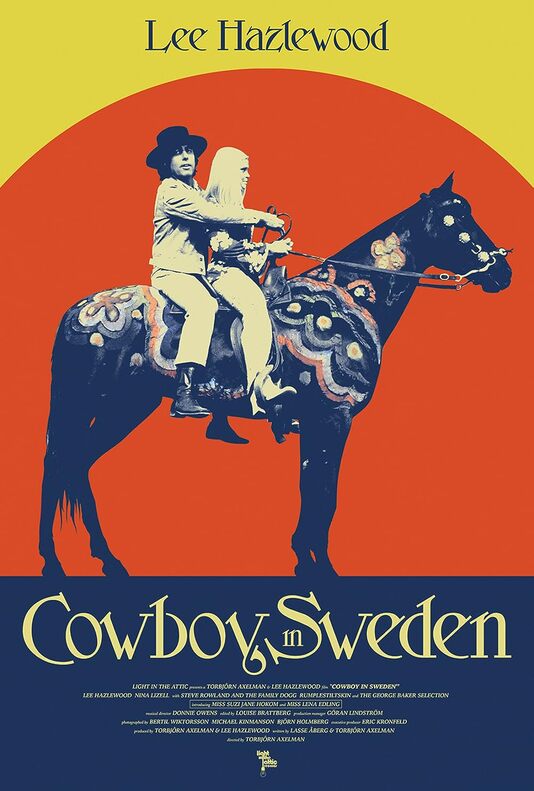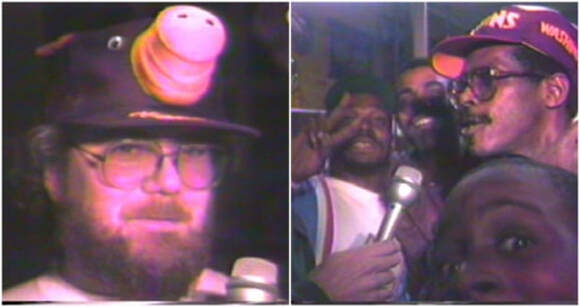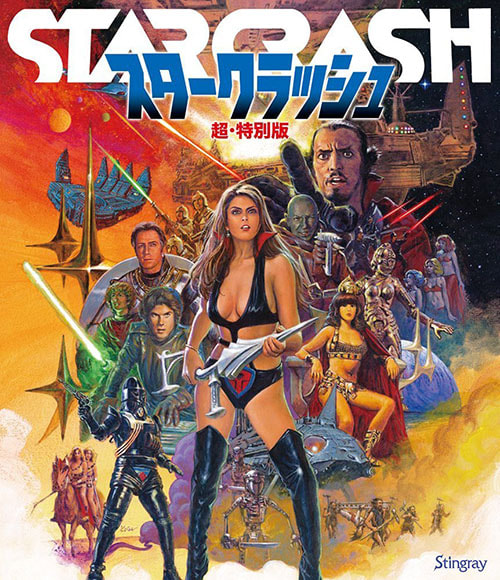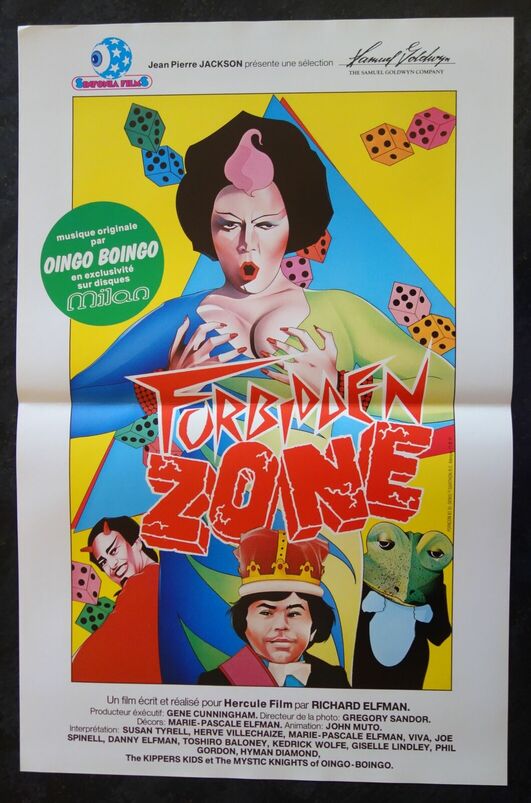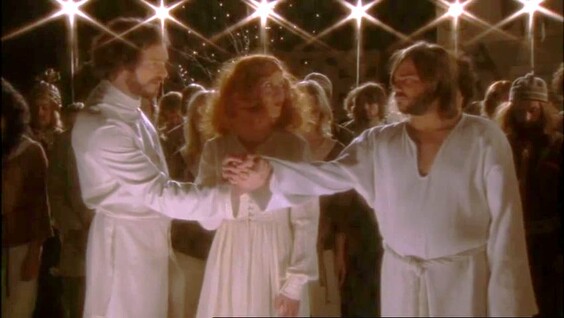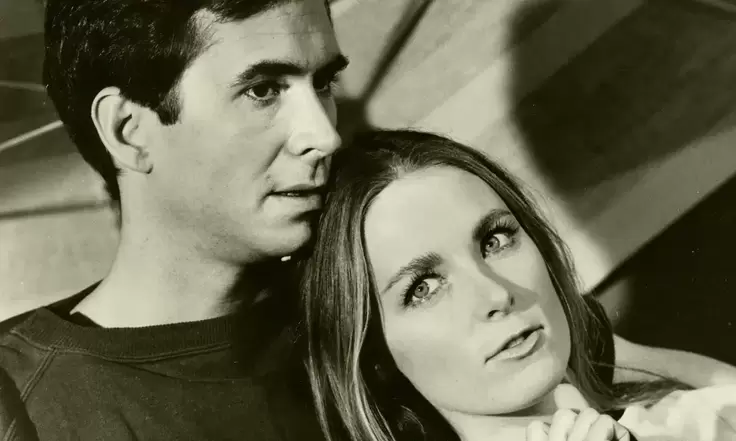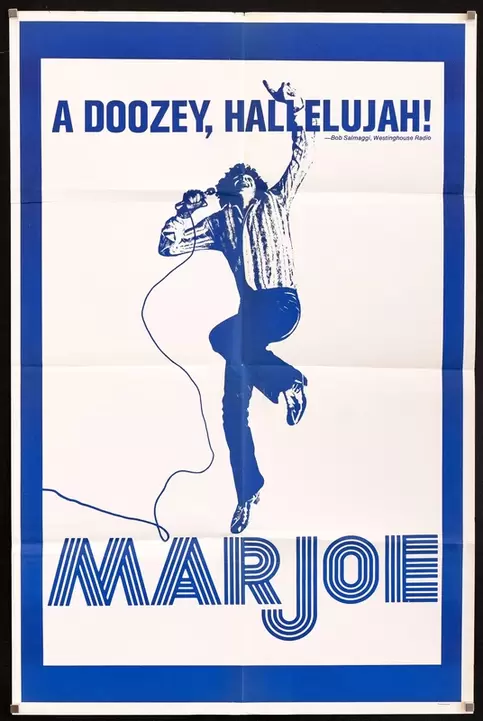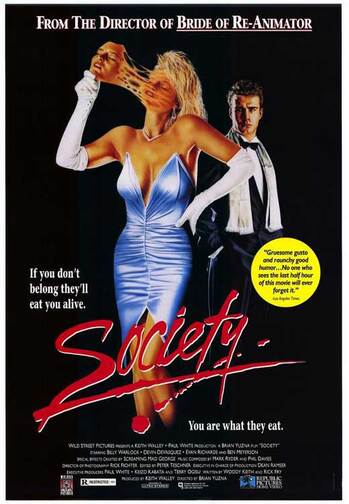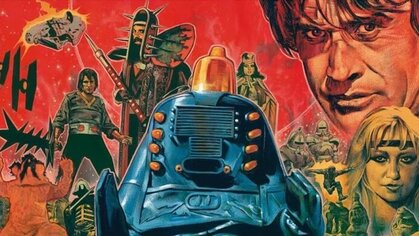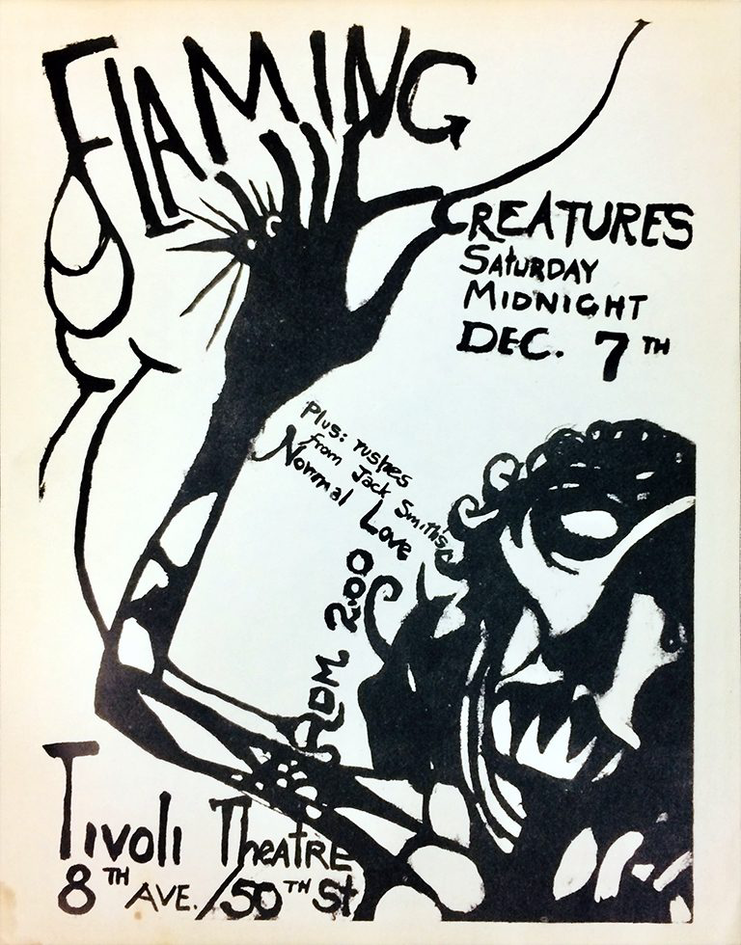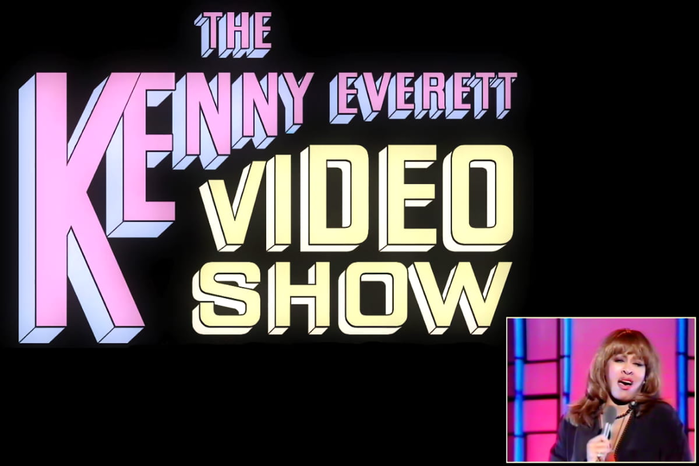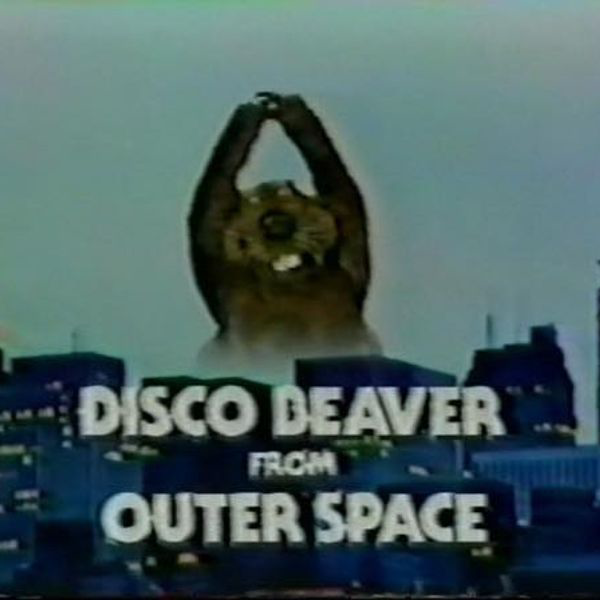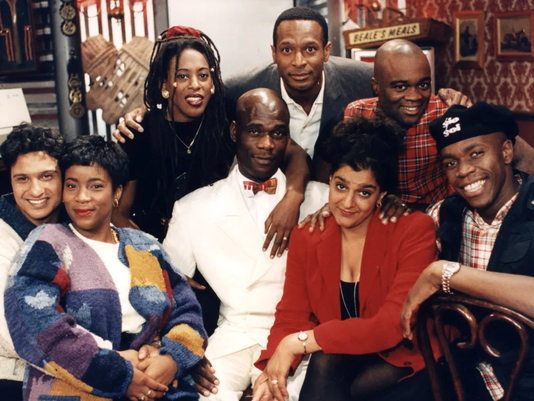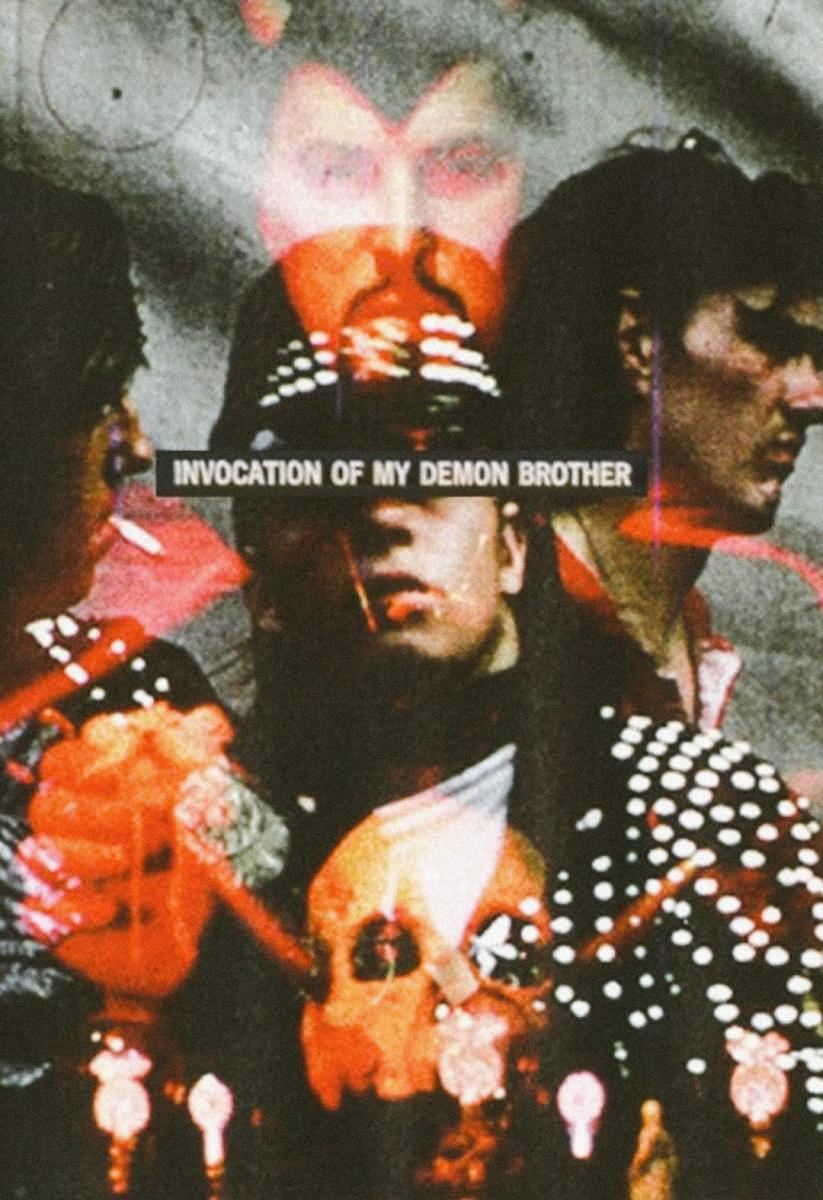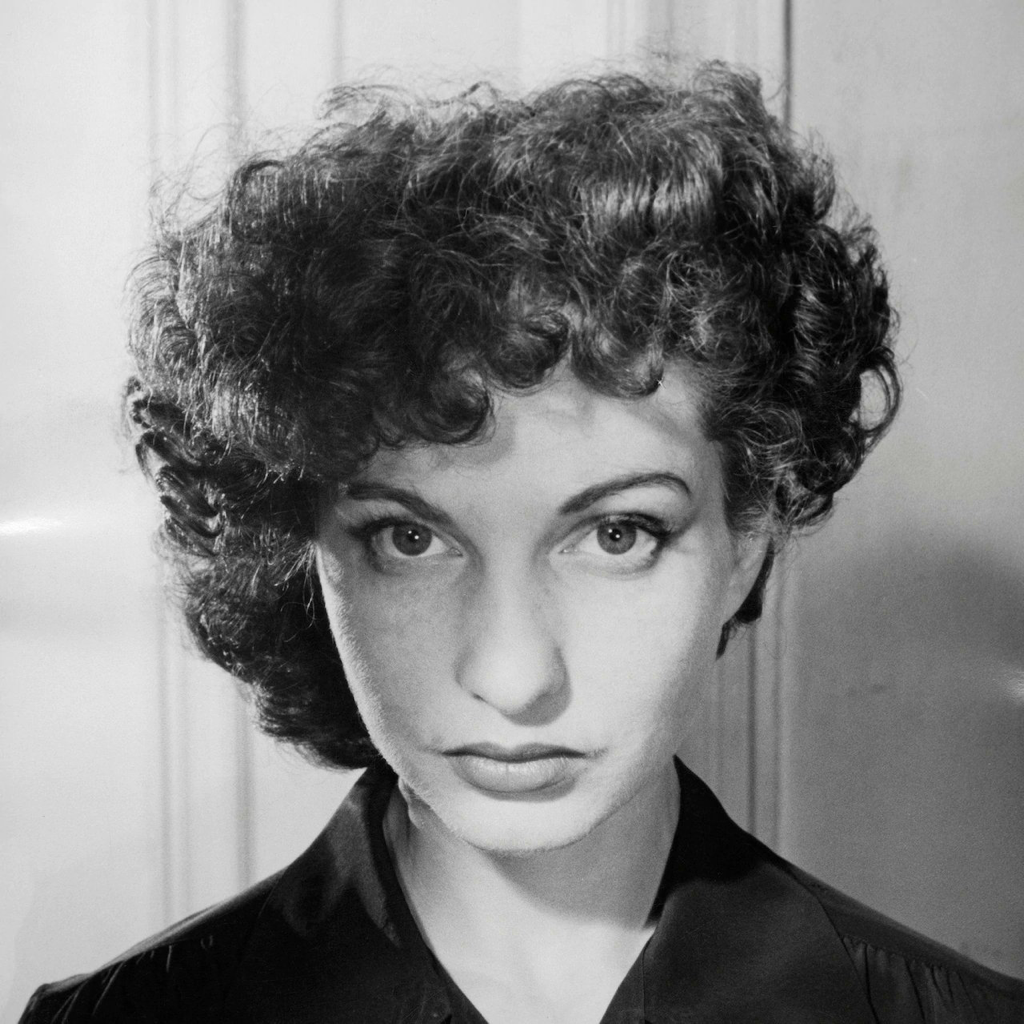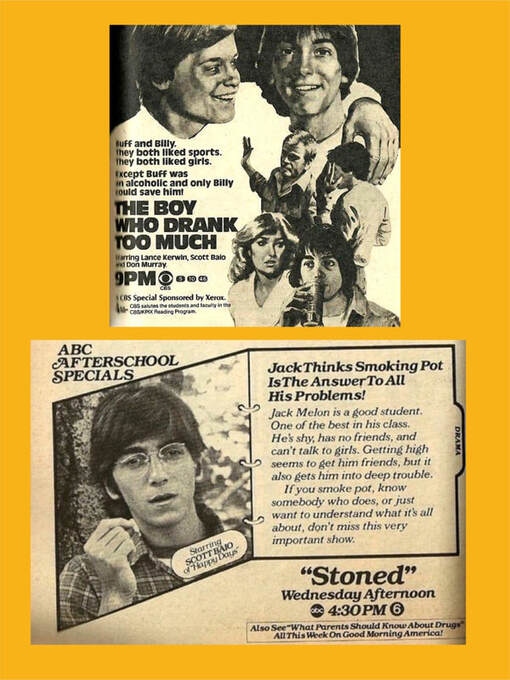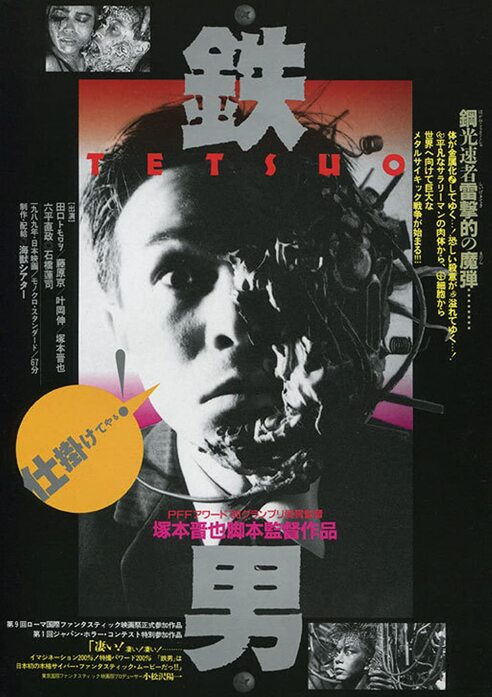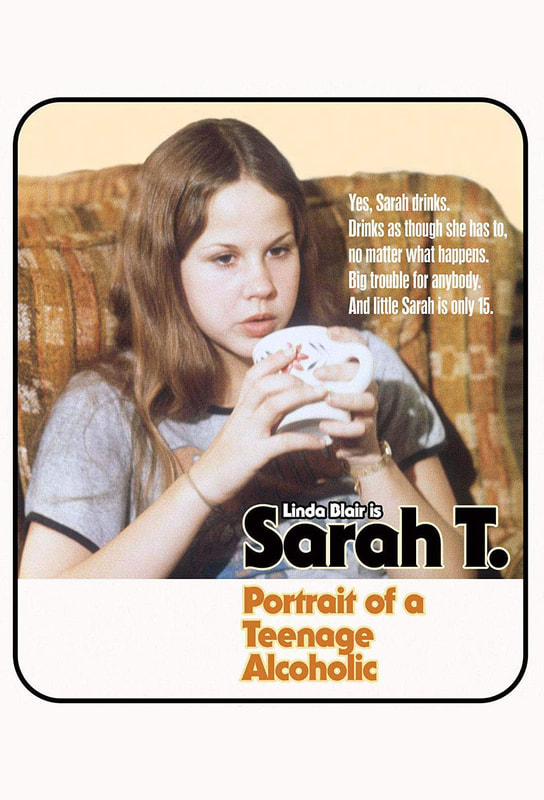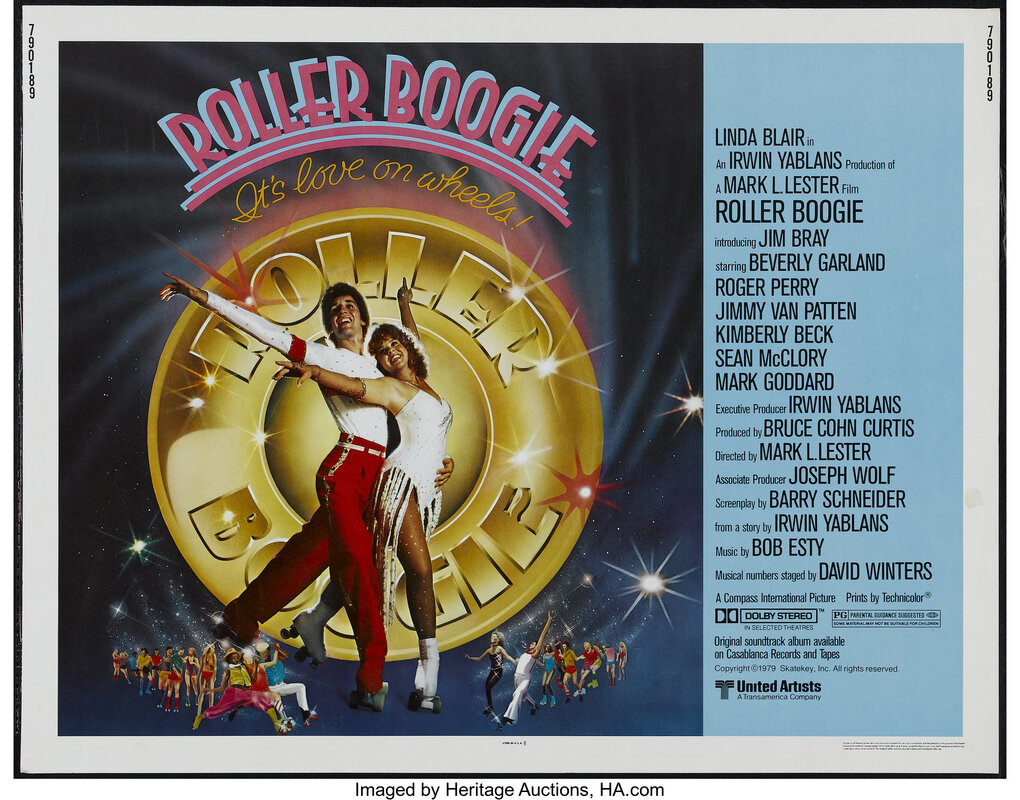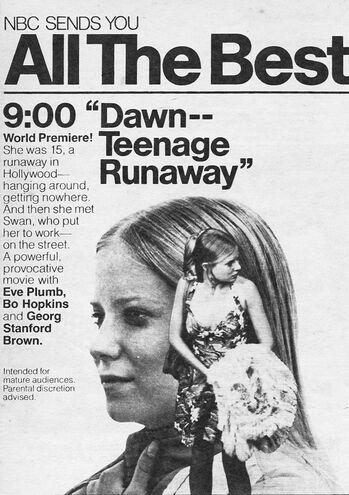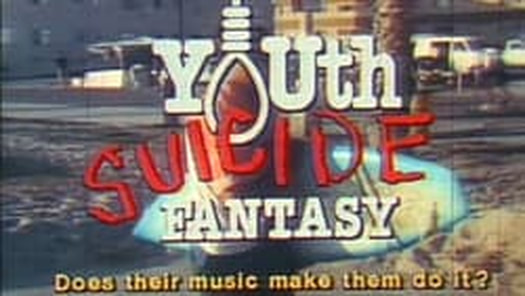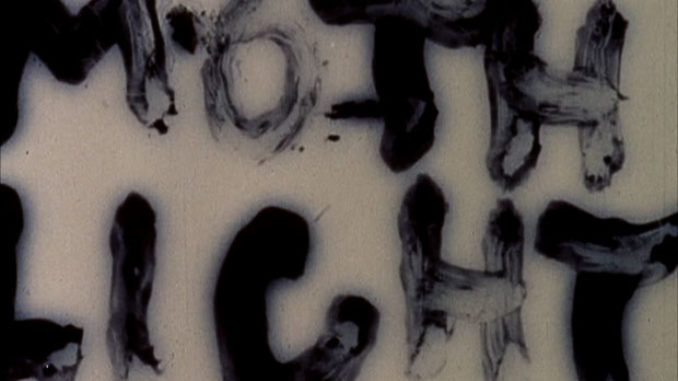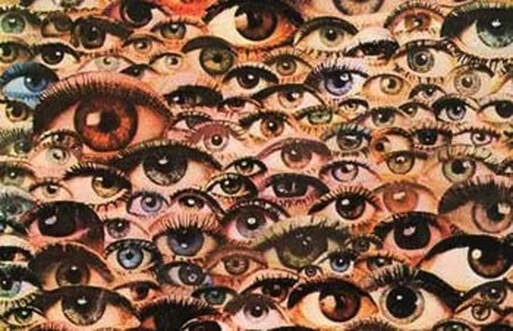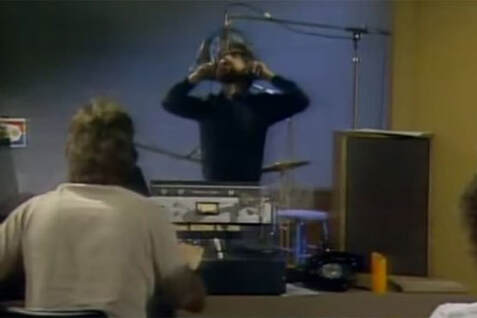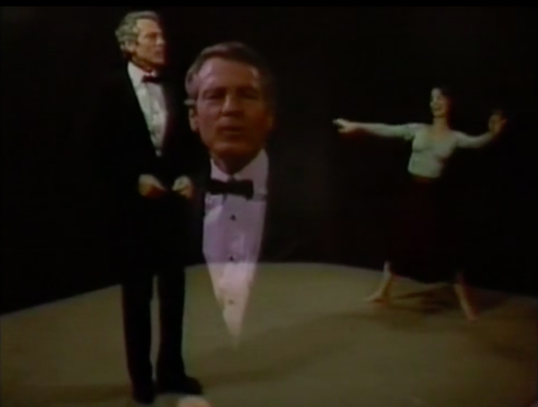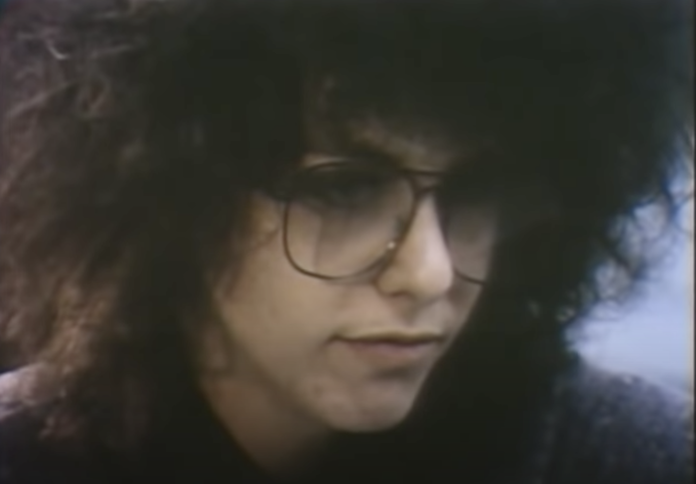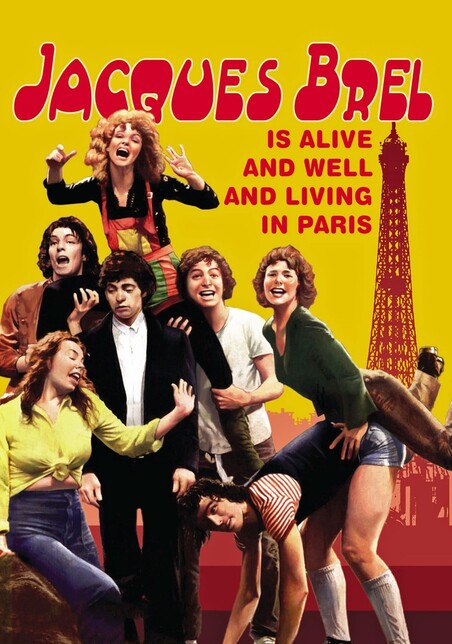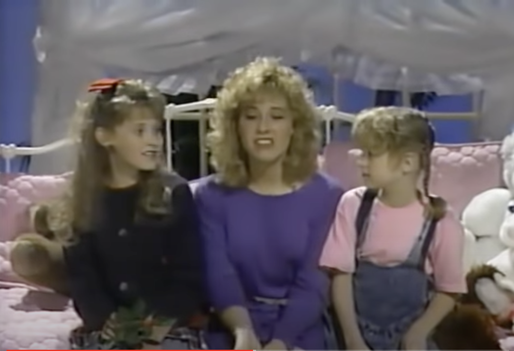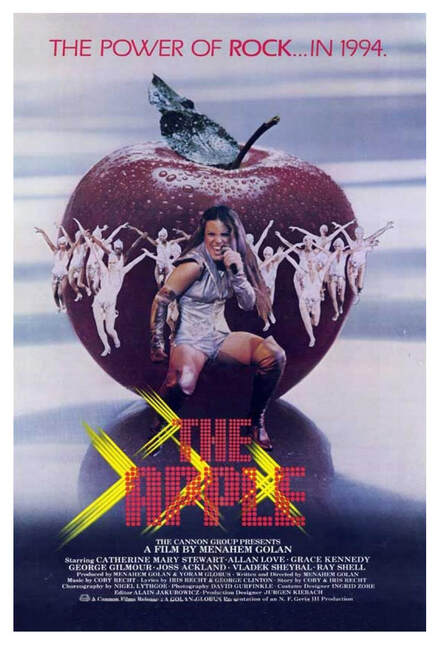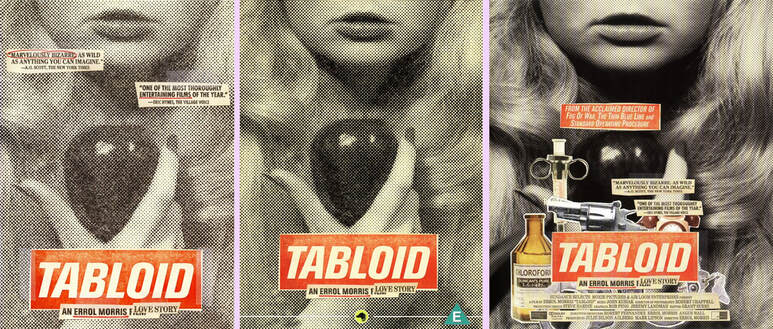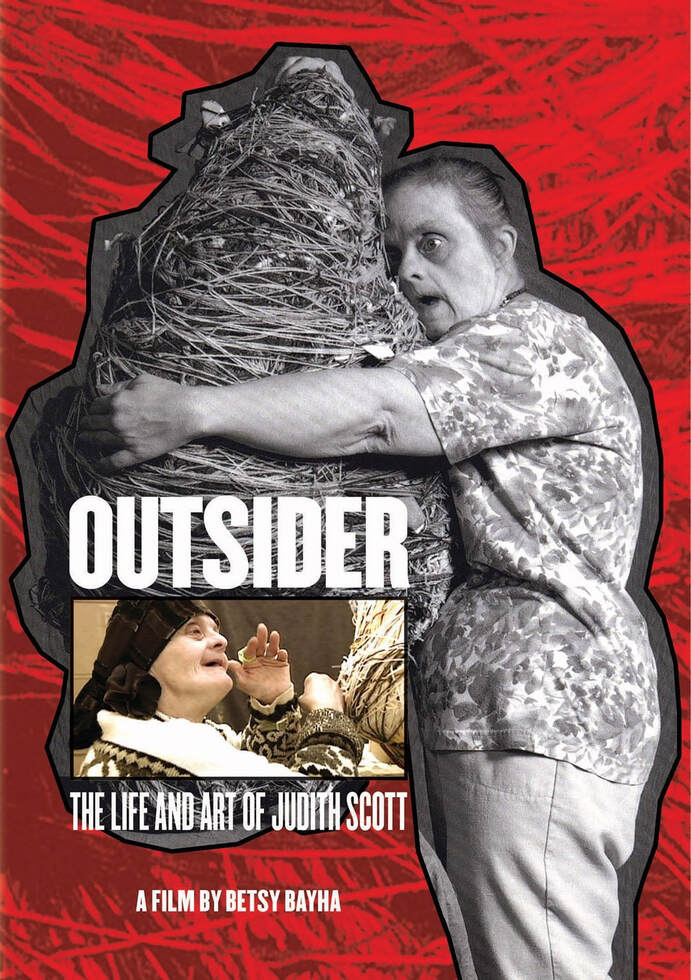Please Support
If you'd like to support this project please join our Patreon. We could really use support to keep this going! Special content, perks, and more!
Subcribe to our Podcast Below
VAA VIDEO
We will be archiving all the music and videos we mention or share on this page. Most links are full films, videos, and playlists. A few will be short videos or trailers.
‘DRUGS: KILLERS AND DILLERS,’ MATT GROENING’S AMUSING ANTI-DRUG PARODY FROM 1972
Matt Groening made his comedic name in the 1980s with the brutally nihilistic alternative comic Life In Hell (a favorite of mine in high school) and went on to far greater fame as the creator of the animated Simpson family as well as the TV series Futurama and Disenchanted.
One of Groening’s early forays into comedy occurred in 1972 when, as a student at Evergreen State College in Olympia, Washington, he co-directed, co-wrote, and appeared in “Drugs: Killers or Dillers?,” a parody of the many inauthentically “authoritative” anti-drug propaganda film strips of that era. National Lampoon and the Firesign Theatre were a very big deal when Groening, Tim Smith, and Jim Angell teamed up to create the nine-and-a-half-minute movie—and you can see that influence pretty strongly here. The movie is amateurish but pretty good, considering.
Groening appears in the opening bit as a hippie degenerate who drinks way too much LSD. My favorite gag involves the eventual demise of a pair of cavemen who pop up to illustrate the origins of drug consumption. The montage of the various types of drugs is quite amusing as well.
The first title card of the movie reads “A TEENS FOR DECENCY PRESENTATION.” When Groening appeared on Late Night with David Letterman in 1989—there’s no way I didn’t watch this episode when it first aired—he mentioned that when he was in high school, he started a group by that name because a teacher had referred to Groening and his friends as “teens for filth.” The group’s motto was “If you’re against decency, what are you for?” and all the members secured election to the student body offices, yay.
https://dangerousminds.net/comments/watch_drugs_killers_and_dillers
Full Video
https://youtu.be/MpBrcH0WETg?si=8HW0_6VsLZwgRliU
One of Groening’s early forays into comedy occurred in 1972 when, as a student at Evergreen State College in Olympia, Washington, he co-directed, co-wrote, and appeared in “Drugs: Killers or Dillers?,” a parody of the many inauthentically “authoritative” anti-drug propaganda film strips of that era. National Lampoon and the Firesign Theatre were a very big deal when Groening, Tim Smith, and Jim Angell teamed up to create the nine-and-a-half-minute movie—and you can see that influence pretty strongly here. The movie is amateurish but pretty good, considering.
Groening appears in the opening bit as a hippie degenerate who drinks way too much LSD. My favorite gag involves the eventual demise of a pair of cavemen who pop up to illustrate the origins of drug consumption. The montage of the various types of drugs is quite amusing as well.
The first title card of the movie reads “A TEENS FOR DECENCY PRESENTATION.” When Groening appeared on Late Night with David Letterman in 1989—there’s no way I didn’t watch this episode when it first aired—he mentioned that when he was in high school, he started a group by that name because a teacher had referred to Groening and his friends as “teens for filth.” The group’s motto was “If you’re against decency, what are you for?” and all the members secured election to the student body offices, yay.
https://dangerousminds.net/comments/watch_drugs_killers_and_dillers
Full Video
https://youtu.be/MpBrcH0WETg?si=8HW0_6VsLZwgRliU
‘COWBOY IN SWEDEN’: WATCH LEE HAZLEWOOD’S INSANE SWEDISH TV SPECIAL, 1970
At the end of the ‘60s, he collaborated with his friend, director Torbjörn Axelman, on the TV special Cowboy in Sweden; Light in the Attic, the label responsible for the latest round of Lee Hazlewood reissues, says this is one of seven Swedish TV movies the singer and Axelman made together. As on the companion album of the same name, singers Nina Lizell and Suzi Jane Hokom played supporting roles in Lee’s weird fantasies.
Presented as a series of dreams, the movie alternates between absurdist skits and songs given totally incongruous visual settings. While much of Cowboy in Sweden is exactly what you’d picture—Hazlewood on horseback, cigarette dangling from his lips, alone with his doleful thoughts—there’s a whole lot in here you’d be unlikely to imagine on your own. I don’t want to spoil it, so I’ll limit myself to a single example. Punning on the song’s title, Hazlewood sings his lonesome prisoner ballad “Pray Them Bars Away” to a group of polar bears swimming in the blinding Scandinavian sun.
Cowboy in Sweden is also a showcase for a few European bands of the time, whose tunes contrast just as jarringly with the scenery: Rumpelstiltskin mime their upbeat “Knock on My Door” in a junk yard, surrounded by flaming auto wrecks, and Steve Rowland and The Family Dogg lip-sync their miserable “Sympathy” in a very pleasant sculpture garden on a beautiful afternoon. At 36:41, there is a promo film for the George Baker Selection’s “Little Green Bag” (the get-up-out-your-seat song Quentin Tarantino later used for the opening credits of Reservoir Dogs) in which the Dutch soul combo lounges around a table, smoking cigarettes and drinking red wine.
If you crave higher quality, the box set There’s A Dream I’ve Been Saving: Lee Hazlewood Industries 1966-1971 apparently includes a DVD with a new digital transfer of Cowboy in Sweden, which I am dying to see.
https://dangerousminds.net/comments/cowboy_in_sweden_watch_lee_hazlewoods_insane_swedish_tv_special_1970
Full Video
https://www.youtube.com/watch?app=desktop&v=tmnSzMArJvw
Presented as a series of dreams, the movie alternates between absurdist skits and songs given totally incongruous visual settings. While much of Cowboy in Sweden is exactly what you’d picture—Hazlewood on horseback, cigarette dangling from his lips, alone with his doleful thoughts—there’s a whole lot in here you’d be unlikely to imagine on your own. I don’t want to spoil it, so I’ll limit myself to a single example. Punning on the song’s title, Hazlewood sings his lonesome prisoner ballad “Pray Them Bars Away” to a group of polar bears swimming in the blinding Scandinavian sun.
Cowboy in Sweden is also a showcase for a few European bands of the time, whose tunes contrast just as jarringly with the scenery: Rumpelstiltskin mime their upbeat “Knock on My Door” in a junk yard, surrounded by flaming auto wrecks, and Steve Rowland and The Family Dogg lip-sync their miserable “Sympathy” in a very pleasant sculpture garden on a beautiful afternoon. At 36:41, there is a promo film for the George Baker Selection’s “Little Green Bag” (the get-up-out-your-seat song Quentin Tarantino later used for the opening credits of Reservoir Dogs) in which the Dutch soul combo lounges around a table, smoking cigarettes and drinking red wine.
If you crave higher quality, the box set There’s A Dream I’ve Been Saving: Lee Hazlewood Industries 1966-1971 apparently includes a DVD with a new digital transfer of Cowboy in Sweden, which I am dying to see.
https://dangerousminds.net/comments/cowboy_in_sweden_watch_lee_hazlewoods_insane_swedish_tv_special_1970
Full Video
https://www.youtube.com/watch?app=desktop&v=tmnSzMArJvw
‘SHOW US YOUR BELLY’: HILARIOUS SHORT DOCUMENTARY OF A SPONTANEOUS SUPER BOWL ’88 STREET PARTY
So, you’ve seen and love Heavy Metal Parking Lot, right? Well, one of the filmmakers behind that legendary documentary, Jeff Krulik, has also been involved with a number of other docs, including Show Us Your Belly, a hilarious ten-minute short shot during a spontaneous Washington DC street party that occurred following the Washington Redskins’ 1988 Super Bowl victory. In the video, we see happy and/or drunk fans whooping it up and mugging for the camera, as interviewers ask the sort of things you’d expect in the moment, but then toss out nonsensical questions and requests that have nothing to do with a Super Bowl celebration. Very funny stuff.
Jeff Krulik’s friend Seth Morris, who Jeff says “was pretty much the mastermind” behind the shoot, provided us with some background and details on how it went down.
Show Me Your Belly was filmed the evening of January 31, 1988, and it was a fun little project that required a little bit of planning, and for the Washington Redskins to upset the favored Denver Broncos during Super Bowl XXll.
Jeff Krulik and I have been very close friends, and partners in crime, since meeting at WMUC-FM, the University of MD free-form radio station, and have been hanging out ever since. I did a punk show and a comedy show at WMUC and, from 1983-93, did Corn Between Your Teeth, a weekly Saturday night comedy/spoken word show on WPFW-FM. Jeff and I have always been Redskins fans and, to give you an idea of just how old we are, when we were young, the Redskins were consistently Super Bowl contenders.
I loved Mal Sharpe’s man-on-the-street interviews, played his material on my show quite often, and had him on my show. Jeff was the Public Access Director at Metrovision Cable and had access to all this cool gear, which served him well with Heavy Metal Parking Lot, and other really great films. Jeff should have been born 150 years ago as he would have given P.T. Barnum a run for his money. Jeff Krulik is also the case study of how you don’t have to do drugs to be absolutely insane, and I say that with great affection. For example, Jeff somehow finagled his way into the maximum-security wing at St. Elizabeth’s Psychiatric Hospital, ostensibly to videotape a soul concert where we mixed with the inmates hoping to run into John Hinkley Jr., Ronald Reagan’s attempted assassin. Jeff looks perfectly normal but, trust me, he’s fuckin nuts!
Although Super Bowl XXII was 31 years ago, I do remember very clearly the day of the game because I had Jeff, my girlfriend Pat Goslee, housemate Liz Evans (who hauled around the 1980’s super-heavy monster battery pack and cables), Steve Kiviat (also from WMUC and has been writing music reviews for nearly 40 years), and some other friends over to my place to watch the Super Bowl, with the goal of heading down to Georgetown with the video gear and asking moronic questions of happy drunk people—if the Skins won the game.
By halftime, when it was clear the Redskins were going to win, we packed up the insanely heavy 1980’s 3/4 video gear and headed to historic Georgetown right as the game ended. Georgetown is the party center of the city, and nobody in DC had to be told that that’s where people were going to go ape-shit. It was unseasonably warm, so I wore my bathing suit (a young woman pulled it down, fortunately off camera), and we just plowed in. People were just ecstatic, jumping up and down, black, white, Latino, Indian, young, old, rich, poor and perfect strangers were hugging each other. The police were cool, nobody was getting hurt and it was a big love-in. When they saw the camera, they assumed we were from a TV station, so everyone asked, “What channel is this?”
The goal was to pay homage to the legendary Mal Sharpe and lift one of his classic questions, but directed to extremely drunk and happy revelers. I did many of the interviews, Steve Kiviat did a few with his classic facial expressions, Jeff asked a few as well, and Pat at the very end.
The ultimate goal was to come away with some funny material, give a nod to Mal Sharpe, and try to add a goofy little time capsule to a really great night in DC sports history. I think we succeeded.
A four-minute cut of Show Us Your Belly was screened during the Don’t Quit Your Day Job Film & Video Festival, which took place on February 5, 1990, at the American Film Institute Theater at the Kennedy Center. This was its only public showing. The program was presented by Jeff Krulik and his collaborator on Heavy Metal Parking Lot, John Heyn.
Embedded below is the complete, ten-minute version of Show Us Your Belly, which was uploaded to Youtube by Jeff. See more videos he’s added to the platform, including some of the other shorts screened during the Don’t Quit Your Day Job fest, below
https://dangerousminds.net/comments/show_us_your_belly_hilarious_short_documentary_of_a_spontaneous_super_bowl_
Full Video
https://www.youtube.com/watch?app=desktop&v=46Zq-Dwb6bQ&embeds_referring_euri=https%3A%2F%2Fdangerousminds.net%2F&feature=emb_logo
Jeff Krulik’s friend Seth Morris, who Jeff says “was pretty much the mastermind” behind the shoot, provided us with some background and details on how it went down.
Show Me Your Belly was filmed the evening of January 31, 1988, and it was a fun little project that required a little bit of planning, and for the Washington Redskins to upset the favored Denver Broncos during Super Bowl XXll.
Jeff Krulik and I have been very close friends, and partners in crime, since meeting at WMUC-FM, the University of MD free-form radio station, and have been hanging out ever since. I did a punk show and a comedy show at WMUC and, from 1983-93, did Corn Between Your Teeth, a weekly Saturday night comedy/spoken word show on WPFW-FM. Jeff and I have always been Redskins fans and, to give you an idea of just how old we are, when we were young, the Redskins were consistently Super Bowl contenders.
I loved Mal Sharpe’s man-on-the-street interviews, played his material on my show quite often, and had him on my show. Jeff was the Public Access Director at Metrovision Cable and had access to all this cool gear, which served him well with Heavy Metal Parking Lot, and other really great films. Jeff should have been born 150 years ago as he would have given P.T. Barnum a run for his money. Jeff Krulik is also the case study of how you don’t have to do drugs to be absolutely insane, and I say that with great affection. For example, Jeff somehow finagled his way into the maximum-security wing at St. Elizabeth’s Psychiatric Hospital, ostensibly to videotape a soul concert where we mixed with the inmates hoping to run into John Hinkley Jr., Ronald Reagan’s attempted assassin. Jeff looks perfectly normal but, trust me, he’s fuckin nuts!
Although Super Bowl XXII was 31 years ago, I do remember very clearly the day of the game because I had Jeff, my girlfriend Pat Goslee, housemate Liz Evans (who hauled around the 1980’s super-heavy monster battery pack and cables), Steve Kiviat (also from WMUC and has been writing music reviews for nearly 40 years), and some other friends over to my place to watch the Super Bowl, with the goal of heading down to Georgetown with the video gear and asking moronic questions of happy drunk people—if the Skins won the game.
By halftime, when it was clear the Redskins were going to win, we packed up the insanely heavy 1980’s 3/4 video gear and headed to historic Georgetown right as the game ended. Georgetown is the party center of the city, and nobody in DC had to be told that that’s where people were going to go ape-shit. It was unseasonably warm, so I wore my bathing suit (a young woman pulled it down, fortunately off camera), and we just plowed in. People were just ecstatic, jumping up and down, black, white, Latino, Indian, young, old, rich, poor and perfect strangers were hugging each other. The police were cool, nobody was getting hurt and it was a big love-in. When they saw the camera, they assumed we were from a TV station, so everyone asked, “What channel is this?”
The goal was to pay homage to the legendary Mal Sharpe and lift one of his classic questions, but directed to extremely drunk and happy revelers. I did many of the interviews, Steve Kiviat did a few with his classic facial expressions, Jeff asked a few as well, and Pat at the very end.
The ultimate goal was to come away with some funny material, give a nod to Mal Sharpe, and try to add a goofy little time capsule to a really great night in DC sports history. I think we succeeded.
A four-minute cut of Show Us Your Belly was screened during the Don’t Quit Your Day Job Film & Video Festival, which took place on February 5, 1990, at the American Film Institute Theater at the Kennedy Center. This was its only public showing. The program was presented by Jeff Krulik and his collaborator on Heavy Metal Parking Lot, John Heyn.
Embedded below is the complete, ten-minute version of Show Us Your Belly, which was uploaded to Youtube by Jeff. See more videos he’s added to the platform, including some of the other shorts screened during the Don’t Quit Your Day Job fest, below
https://dangerousminds.net/comments/show_us_your_belly_hilarious_short_documentary_of_a_spontaneous_super_bowl_
Full Video
https://www.youtube.com/watch?app=desktop&v=46Zq-Dwb6bQ&embeds_referring_euri=https%3A%2F%2Fdangerousminds.net%2F&feature=emb_logo
Star Crash - 1978
My streaming gem: why you should watch Starcrash
https://amp.theguardian.com/film/2020/apr/13/starcrash-david-hasselhoff-film-amazon-prime
When the Emperor of the First Circle of the Universe (that is, Christopher Plummer, in a patent leather suit beneath silver armor, a cape and oven mitt-like gloves) wants to calm his worried son (David Hasselhoff) during a climactic moment, he steps forward amid a room full of warriors and slain robots and bellows: “Imperial Battleship – stop the flow of time!!!”It is an apogee of trash brilliance unrivaled anywhere else in the galaxy.
My streaming gem: why you should watch The Bigamist
The Star Wars big bang created a universe that is still expanding, but never was the fiery scream of that first eruption felt more furiously than in the late 1970s. Producers far and wide hitched their fortunes to the Millennium Falcon’s hyperdrive, to varying measures of financial and artistic success.
It got Star Trek (the far superior of the two franchises) back into business, with the curiously terrific Star Trek: The Motion Picture in 1979 and begat Battlestar Galactica in 1978, Flash Gordon in 1980 and Buck Rogers in the 25th Century in 1979.
But these are the more respectable titles. On the lower budget shelf came Battle Beyond the Stars (penned on assignment by John Sayles), Galaxina (starring Playboy playmate Dorothy Stratten) and one of the all-time pieces of junk, Italy’s Cosmos: War of the Planets.
In the middle of all this is something that demands further study. Mixing low-budget schlock with genuine design brilliance is Starcrash. Produced at Rome’s Cinecittà Studios in 1978 and distributed by Roger Corman’s New World Pictures, Starcrash was directed and co-written by future Dario Argento collaborator Luigi Cozzi (credited as Lewis Coates)
Full Film Link
https://archive.org/details/Starcrash
https://amp.theguardian.com/film/2020/apr/13/starcrash-david-hasselhoff-film-amazon-prime
When the Emperor of the First Circle of the Universe (that is, Christopher Plummer, in a patent leather suit beneath silver armor, a cape and oven mitt-like gloves) wants to calm his worried son (David Hasselhoff) during a climactic moment, he steps forward amid a room full of warriors and slain robots and bellows: “Imperial Battleship – stop the flow of time!!!”It is an apogee of trash brilliance unrivaled anywhere else in the galaxy.
My streaming gem: why you should watch The Bigamist
The Star Wars big bang created a universe that is still expanding, but never was the fiery scream of that first eruption felt more furiously than in the late 1970s. Producers far and wide hitched their fortunes to the Millennium Falcon’s hyperdrive, to varying measures of financial and artistic success.
It got Star Trek (the far superior of the two franchises) back into business, with the curiously terrific Star Trek: The Motion Picture in 1979 and begat Battlestar Galactica in 1978, Flash Gordon in 1980 and Buck Rogers in the 25th Century in 1979.
But these are the more respectable titles. On the lower budget shelf came Battle Beyond the Stars (penned on assignment by John Sayles), Galaxina (starring Playboy playmate Dorothy Stratten) and one of the all-time pieces of junk, Italy’s Cosmos: War of the Planets.
In the middle of all this is something that demands further study. Mixing low-budget schlock with genuine design brilliance is Starcrash. Produced at Rome’s Cinecittà Studios in 1978 and distributed by Roger Corman’s New World Pictures, Starcrash was directed and co-written by future Dario Argento collaborator Luigi Cozzi (credited as Lewis Coates)
Full Film Link
https://archive.org/details/Starcrash
Attack of the Killer Tomatoes - 1978
Attack of the Killer Tomatoes: An Oral History of the 1978 Film
The definitive oral history of "Attack of the Killer Tomatoes," the 1978 film judged the Worst Vegetable Movie of All Time
In 1978, Attack of the Killer Tomatoes was set loose into the world. Billed as a musical-comedy-horror show, famous for its weirdly catchy theme song, and feted as the Worst Vegetable Movie Ever Made, it's a film in the vein of (and made at the exact same time as) Kentucky Fried Movie and Airplane!, as well as the Mel Brooks and Monty Python comedies that preceded it. Spoofing schlocky B movies from the 1950s and '60s, it follows the course of a seemingly unstoppable tomato attack on America and the brave team of government agents pledged to stop it in its tracks. There are musical numbers, and topical jokes from the 1970s, and lots and lots of people screaming as tomatoes both giant and normal-sized sit next to them.It's the perfect tomato movie. Against all odds, it became a part of pop culture, spawning three sequels (including
George Clooney's first second feature film!) and an animated spin-off series. Mention the title to people of a certain age, and they'll either roll their eyes or start giggling uncontrollably. One reviewer called it "hopelessly inane," and the film's creators took that as a badge of honor, putting it on the Director's Cut DVD. It's been 36 years since three friends in San Diego, just out of college--Costa Dillon, John DeBello, and Steve Peace--decided to take a break from their sports-reel business to make a ridiculous movie. And now, as we learned while reporting this piece, a relaunch of the series is planned for 2015. So we thought it was high time to talk to as many people involved with Attack of the Killer Tomatoes as possible, and compile the definitive history of a movie hailed by USA Today as having "one of the five best movie titles of all time."
Costa: I saw Attack of the Mushroom People, and I remember thinking,
How dumb is this? And suddenly got the idea that we could do something even sillier. I don't know why tomatoes came to mind first, maybe because they seemed so innocuous.
John: The idea was that "killer tomatoes" was about the stupidest thing you could come up with. It's probably one of the few films that came into existence because of a title.
Full Film Link
https://archive.org/details/attack-of-the-killer-tomatoes_202305
The definitive oral history of "Attack of the Killer Tomatoes," the 1978 film judged the Worst Vegetable Movie of All Time
In 1978, Attack of the Killer Tomatoes was set loose into the world. Billed as a musical-comedy-horror show, famous for its weirdly catchy theme song, and feted as the Worst Vegetable Movie Ever Made, it's a film in the vein of (and made at the exact same time as) Kentucky Fried Movie and Airplane!, as well as the Mel Brooks and Monty Python comedies that preceded it. Spoofing schlocky B movies from the 1950s and '60s, it follows the course of a seemingly unstoppable tomato attack on America and the brave team of government agents pledged to stop it in its tracks. There are musical numbers, and topical jokes from the 1970s, and lots and lots of people screaming as tomatoes both giant and normal-sized sit next to them.It's the perfect tomato movie. Against all odds, it became a part of pop culture, spawning three sequels (including
George Clooney's first second feature film!) and an animated spin-off series. Mention the title to people of a certain age, and they'll either roll their eyes or start giggling uncontrollably. One reviewer called it "hopelessly inane," and the film's creators took that as a badge of honor, putting it on the Director's Cut DVD. It's been 36 years since three friends in San Diego, just out of college--Costa Dillon, John DeBello, and Steve Peace--decided to take a break from their sports-reel business to make a ridiculous movie. And now, as we learned while reporting this piece, a relaunch of the series is planned for 2015. So we thought it was high time to talk to as many people involved with Attack of the Killer Tomatoes as possible, and compile the definitive history of a movie hailed by USA Today as having "one of the five best movie titles of all time."
Costa: I saw Attack of the Mushroom People, and I remember thinking,
How dumb is this? And suddenly got the idea that we could do something even sillier. I don't know why tomatoes came to mind first, maybe because they seemed so innocuous.
John: The idea was that "killer tomatoes" was about the stupidest thing you could come up with. It's probably one of the few films that came into existence because of a title.
Full Film Link
https://archive.org/details/attack-of-the-killer-tomatoes_202305
Forbidden Zone - 1982
The science-fiction cult secret Forbidden Zone was 40 years ahead of its timeThe 1982 cult hit looks like a movie musical from a different dimension
The first three minutes go a long way in helping viewers determine whether they’re in the film’s love camp, or its berserk hate-camp. A text scroll places the action in Venice, California on Friday, April 17th at 4 o’clock. That’s the script’s lone tether to Earth. The film reveals that Huckleberry P. Jones, “local pimp, narcotics peddler, and slum-lord,” has discovered a portal to another dimension in one of his stash houses. Elfman then launches his running homage to movie musicals of the pre-war era by representing Jones as a old-fashioned blackface caricature, first in cartoon form, then in antic live-action. The Al Jolson doppelgänger hightails it out of the house, and just like that, we’re descending into the hand-drawn bowels of the interdimensional rift for the credits sequence.
To the New Wave strains of the Mystic Knights of the Oingo Boingo, we’re fleetingly acquainted with a series of oddballs, including frog-headed butler Bust Rod and a nameless, topless princess. The train is leaving the station, and by that time, everyone in the audience is aware whether they’re going along for the ride, or jumping off.
Forty years ago, The Forbidden Zone’s theatrical release prompted arson threats from moviegoers, and a formal ban from the University of Wisconsin. These days, it’s easier than ever for people vibrating on Elfman’s sui generis wavelength to join him in this realm of madness. The widespread availability of streaming cult titles has scrubbed away some of the mystique that came with the former rarity of this sort of film, but Forbidden Zone’s sheer gleeful-strangeness quotient still humbles that of any big-screen musical that’s come since. In keeping with the theme of reality-hopping, Elfman envisioned genre as it might have evolved in an alternate universe, overhauling musicals and the booming science-fiction tradition with equal imagination.
https://www.polygon.com/platform/amp/2020/4/7/21206051/forbidden-zone-richard-danny-elfman-oingo-boingo-cult-film-anniversary
Full Film Link
https://archive.org/details/ForbiddenZone1980_201905
- By Charles Bramesco
- on April 7, 2020 8:22 pm
The first three minutes go a long way in helping viewers determine whether they’re in the film’s love camp, or its berserk hate-camp. A text scroll places the action in Venice, California on Friday, April 17th at 4 o’clock. That’s the script’s lone tether to Earth. The film reveals that Huckleberry P. Jones, “local pimp, narcotics peddler, and slum-lord,” has discovered a portal to another dimension in one of his stash houses. Elfman then launches his running homage to movie musicals of the pre-war era by representing Jones as a old-fashioned blackface caricature, first in cartoon form, then in antic live-action. The Al Jolson doppelgänger hightails it out of the house, and just like that, we’re descending into the hand-drawn bowels of the interdimensional rift for the credits sequence.
To the New Wave strains of the Mystic Knights of the Oingo Boingo, we’re fleetingly acquainted with a series of oddballs, including frog-headed butler Bust Rod and a nameless, topless princess. The train is leaving the station, and by that time, everyone in the audience is aware whether they’re going along for the ride, or jumping off.
Forty years ago, The Forbidden Zone’s theatrical release prompted arson threats from moviegoers, and a formal ban from the University of Wisconsin. These days, it’s easier than ever for people vibrating on Elfman’s sui generis wavelength to join him in this realm of madness. The widespread availability of streaming cult titles has scrubbed away some of the mystique that came with the former rarity of this sort of film, but Forbidden Zone’s sheer gleeful-strangeness quotient still humbles that of any big-screen musical that’s come since. In keeping with the theme of reality-hopping, Elfman envisioned genre as it might have evolved in an alternate universe, overhauling musicals and the booming science-fiction tradition with equal imagination.
https://www.polygon.com/platform/amp/2020/4/7/21206051/forbidden-zone-richard-danny-elfman-oingo-boingo-cult-film-anniversary
Full Film Link
https://archive.org/details/ForbiddenZone1980_201905
Matt Berry and Richard Ayoade’s ‘AD/BC: A Rock Opera
Ayoade and Berry joined forces to create for BBC Three – AD/BC: A Rock Opera.
Despite featuring a cast who are now much more recognisable than they were back then, the one-off, half-hour comedy special has never been repeated by the BBC since its initial broadcast in 2004, and it seems to have slipped under the radar of even the most ardent comedy fans. What Ayoade and Berry created for BBC Three was a parody of the religious-themed musicals (or more specifically ‘rock operas’) that were popular in the early 1970s such as Jesus Christ Superstar and Joseph.
As such, AD/BC is packed with the staples of this genre: ‘70s fashion and slang in contrast with the 1BC setting, absurdly high vocal notes being held for far too long, mundane lines being dramatically belted out rather than spoken, and of course plenty of poor dubbing and shaky camerawork.
What was it about?
It’s 1978 and composer Tim Wynde (Matt Berry) introduces us to a broadcast of AD/BC, a rock opera he wrote (and starred in) about the birth of Jesus, which has been recorded for television confined to a single studio with an obviously low budget.
Wynde’s version of the nativity story (which he so modestly refers to as “the greatest story never told”) happens from the viewpoint of the Innkeeper who gives shelter to Mary and Joseph, and naturally this hitherto unexplored character has his own problems to deal with before the couple arrive on his doorstep.
The Innkeeper’s business is struggling, his wife is on the verge of leaving him, and he owes money to rival hotel owner Tony Iscariot “whose son went on to even greater infamy, but I guess that’s another story”.
Who was in it?
In addition to writing AD/BC (and also directing it, in Ayoade’s case), Matt Berry and Richard Ayoade star as the Innkeeper and Joseph respectively.
The other two leading roles are taken by Julian Barratt (The Mighty Boosh) as Tony Iscariot and Julia Davis (Nighty Night) as Ruth, the Innkeeper’s wife.
https://cultbox.co.uk/features/rewind/adbc-a-rock-opera-review
Full Video
https://youtu.be/JS1eTb6smNM
Despite featuring a cast who are now much more recognisable than they were back then, the one-off, half-hour comedy special has never been repeated by the BBC since its initial broadcast in 2004, and it seems to have slipped under the radar of even the most ardent comedy fans. What Ayoade and Berry created for BBC Three was a parody of the religious-themed musicals (or more specifically ‘rock operas’) that were popular in the early 1970s such as Jesus Christ Superstar and Joseph.
As such, AD/BC is packed with the staples of this genre: ‘70s fashion and slang in contrast with the 1BC setting, absurdly high vocal notes being held for far too long, mundane lines being dramatically belted out rather than spoken, and of course plenty of poor dubbing and shaky camerawork.
What was it about?
It’s 1978 and composer Tim Wynde (Matt Berry) introduces us to a broadcast of AD/BC, a rock opera he wrote (and starred in) about the birth of Jesus, which has been recorded for television confined to a single studio with an obviously low budget.
Wynde’s version of the nativity story (which he so modestly refers to as “the greatest story never told”) happens from the viewpoint of the Innkeeper who gives shelter to Mary and Joseph, and naturally this hitherto unexplored character has his own problems to deal with before the couple arrive on his doorstep.
The Innkeeper’s business is struggling, his wife is on the verge of leaving him, and he owes money to rival hotel owner Tony Iscariot “whose son went on to even greater infamy, but I guess that’s another story”.
Who was in it?
In addition to writing AD/BC (and also directing it, in Ayoade’s case), Matt Berry and Richard Ayoade star as the Innkeeper and Joseph respectively.
The other two leading roles are taken by Julian Barratt (The Mighty Boosh) as Tony Iscariot and Julia Davis (Nighty Night) as Ruth, the Innkeeper’s wife.
https://cultbox.co.uk/features/rewind/adbc-a-rock-opera-review
Full Video
https://youtu.be/JS1eTb6smNM
Stephen Sondheim - Evening Primrose (1966) ABC Stage 67
In 1966, Sondheim and James Goldman wrote this adaptation of John Collier's short story "Evening Primrose" for the television series ABC Stage 67. Stage 67 was the brainchild of producer Hubbel Robinson, and wass an ambitious series of original hourlong musicals and dramas for television. Sadly, the series never clicked with viewers who were much more at home with Bewitched, Green Acres, and The Beverly Hillbillies. The writers of the other musicals on Stage 67 included Bock and Harnick (The Centerville Ghost), Bacharach and David (On the Flip Side), Styne and Comden and Green (Getting Married) and Richard Adler (Olympus 70000). Still, despite all the talent, the only real critical successes of the show were "Primrose" and Sam Peckinpah's adaptation of Katherine Anne Porter's "Noon Wine".
Evening Primrose is the story of Charles, a poet who has renounced the world and who has decided to live in a deprtment store and write poetry ("If You Can Find Me, I'm Here"). He soon discovers he is not alone, that there's a secret society which has lived in the store for years. Charles Mrs. Munday, the leader of the society; she decides he can stay after he convinces her that he really is a poet. Charles also meets Ella Harkins, Mrs. Munday's maid, with whom he is immediately taken. Ella is very unhappy, but afraid to leave because of the Dark Men. She explains to Charles that at Journey's End, a mortuary, there is another secret society. If someone in the society at the department store tries to return to the outside world and thus risk revealing the society's existence, the Dark Men come from the mortuary, that person is taken by them to the Surgical Supplies and when they are finished there's another mannequin in the clothing department.
Ella, who is 19, has lived in the store since she was six - she was there with her mother, got separated and fell asleep in Women's Hats. Mrs. Munday found her and kept her for her maid. Amazed, Charles says, "You haven't seen the sun for thirteen years." To which Ella replies, "Don't pity me - I have my memories," and sings "I Remember". Charles is falling in love with Ella. While he plays contract bridge Mrs. Munday and the others, he and Ella carry on an interior duet in the song "When". The song continues as they go about their seperate tasks - he, writing; she, cleaning. Finally, Ella expresses her desire to flee with Charles in "Take Me To The World". At first reluctant to leave his new life, he realizes that "I Love You more than poetry." Unfortunately, they are overheard by Mrs. Monday and the others, and the Dark Men are called. Ella and Charles try to escape from the Dark Men.In the final shot of the show, a young couple stand in front of a display window outside the department store, admiring the handsome bride and groom mannequins - Charles and Ella.
- Bruce Kimmel
Full Video
https://www.youtube.com/watch?app=desktop&v=kA5lZZ4-QZ8
Evening Primrose is the story of Charles, a poet who has renounced the world and who has decided to live in a deprtment store and write poetry ("If You Can Find Me, I'm Here"). He soon discovers he is not alone, that there's a secret society which has lived in the store for years. Charles Mrs. Munday, the leader of the society; she decides he can stay after he convinces her that he really is a poet. Charles also meets Ella Harkins, Mrs. Munday's maid, with whom he is immediately taken. Ella is very unhappy, but afraid to leave because of the Dark Men. She explains to Charles that at Journey's End, a mortuary, there is another secret society. If someone in the society at the department store tries to return to the outside world and thus risk revealing the society's existence, the Dark Men come from the mortuary, that person is taken by them to the Surgical Supplies and when they are finished there's another mannequin in the clothing department.
Ella, who is 19, has lived in the store since she was six - she was there with her mother, got separated and fell asleep in Women's Hats. Mrs. Munday found her and kept her for her maid. Amazed, Charles says, "You haven't seen the sun for thirteen years." To which Ella replies, "Don't pity me - I have my memories," and sings "I Remember". Charles is falling in love with Ella. While he plays contract bridge Mrs. Munday and the others, he and Ella carry on an interior duet in the song "When". The song continues as they go about their seperate tasks - he, writing; she, cleaning. Finally, Ella expresses her desire to flee with Charles in "Take Me To The World". At first reluctant to leave his new life, he realizes that "I Love You more than poetry." Unfortunately, they are overheard by Mrs. Monday and the others, and the Dark Men are called. Ella and Charles try to escape from the Dark Men.In the final shot of the show, a young couple stand in front of a display window outside the department store, admiring the handsome bride and groom mannequins - Charles and Ella.
- Bruce Kimmel
Full Video
https://www.youtube.com/watch?app=desktop&v=kA5lZZ4-QZ8
It Came from Kuchar
IT CAME FROM KUCHAR is a hilarious and touching story of artistic obsession, compulsion and inspiration.
Long before YouTube, there were the outrageous, no-budget movies of underground, filmmaking twins George and Mike Kuchar. George and Mike grew up in the Bronx in the 1950’s. At the age of twelve, they became obsessed with Hollywood melodramas and began making their own homespun melodramas with their aunt’s 8mm camera. They used their friends and family as actors and their Bronx neighborhood as their set. Early Kuchar titles featured in this film include “I Was A Teenage Rumpot” and “Born of the Wind”.
In the early 1960’s, alongside Andy Warhol, the Kuchar brothers shaped the New York underground film scene. Known as the “8mm Mozarts”, their films were noticeably different than other underground films of the time. They were wildly funny, but also human and vulnerable.
Their films have inspired many filmmakers, including John Waters, Buck Henry, Atom Egoyan, Guy Maddin and Wayne Wang (all are interviewed in this film). Despite having high profile fans, the Kuchars remain largely unknown because they are only ambitious to make movies, not to be famous.
“It Came From Kuchar” interweaves the brothers’ lives, their admirers, a history of underground film and a “greatest hits” of Kuchar clips into a mesmerizing stream of consciousness tale.
Affectionately directed by one of George’s former students, Jennifer M. Kroot, “It Came From Kuchar” will introduce you to the amazing Kuchar brothers – two brothers who love to make movies and continue to inspire others.
Full Film
https://youtu.be/WwZoUX3CxXE
Long before YouTube, there were the outrageous, no-budget movies of underground, filmmaking twins George and Mike Kuchar. George and Mike grew up in the Bronx in the 1950’s. At the age of twelve, they became obsessed with Hollywood melodramas and began making their own homespun melodramas with their aunt’s 8mm camera. They used their friends and family as actors and their Bronx neighborhood as their set. Early Kuchar titles featured in this film include “I Was A Teenage Rumpot” and “Born of the Wind”.
In the early 1960’s, alongside Andy Warhol, the Kuchar brothers shaped the New York underground film scene. Known as the “8mm Mozarts”, their films were noticeably different than other underground films of the time. They were wildly funny, but also human and vulnerable.
Their films have inspired many filmmakers, including John Waters, Buck Henry, Atom Egoyan, Guy Maddin and Wayne Wang (all are interviewed in this film). Despite having high profile fans, the Kuchars remain largely unknown because they are only ambitious to make movies, not to be famous.
“It Came From Kuchar” interweaves the brothers’ lives, their admirers, a history of underground film and a “greatest hits” of Kuchar clips into a mesmerizing stream of consciousness tale.
Affectionately directed by one of George’s former students, Jennifer M. Kroot, “It Came From Kuchar” will introduce you to the amazing Kuchar brothers – two brothers who love to make movies and continue to inspire others.
Full Film
https://youtu.be/WwZoUX3CxXE
Marjoe (1972) Documentary
Marjoe is the story of an abused child preacher who grows up to become an Evangelical con man, living a double life as a dope-smoking, girl-chasing hippie in LA. The documentary went on to win the 1972 Academy Award for Best Documentary Feature and earned massive amounts of critical acclaim. But despite the accolades and outrageous story, the film was only played in a handful of theaters on the coasts and was never screened below the Bible Belt. It was eventually forgotten and thought to be lost for good due to the only known copy being badly damaged. However, in 2002, the original negative was rediscovered and the film was released three years later on DVD, introducing Marjoe to a new generation with a greater appetite for films that were critical of religious institutions.
Born in 1944, the film's subject, Marjoe Gortner, was a child star of the Evangelical Christian circuit who became an ordained minister at the age of four. (His parents derived his name from a combination of Mary and Joseph.) Throughout his childhood, he officiated weddings, delivered theatrical sermons, and earned his parents an estimated $3 million, none of which he ever saw. Marjoe alleges that he was subject to emotional and physical abuse by his parents, who he says subjected him to a type of waterboarding when he had difficulty memorizing sermons. At 16, he ran away and fell into the blossoming counterculture of 1960s California.
Marjoe returned to the Evangelical tent-revival circuit in his 20s, capitalizing on his adolescent fame. Marjoe admits in the film that he was never a believer in Christ as an adult or a child, and by his late 20s he began to feel guilty for profiting from the hellfire and damnation services he believed were psychologically harmful to people.
Seeking a music and acting career outside of religion, Marjoe relocated to New York City, reaching out to Village Voice columnist Howard Smith about doing a profile on "The World's Youngest Preacher" who was now all grown up. Smith wasn't interested in the story, but his girlfriend, 25-year-old Sarah Kernochan, had the idea of making a documentary on Marjoe. She and Smith, both new to the medium, co-directed the film, which shows Marjoe performing at Evangelical churches and revealing industry tricks of how to squeeze every last dime out of an audience.
Article
https://www.vice.com/en/article/ppm45m/marjoe-director-sarah-kernochan-talks-about-her-incredible-doc-on-the-evangelical-conman-456
Full Movie Link
https://archive.org/details/Marjoe.1972.Legendado
Born in 1944, the film's subject, Marjoe Gortner, was a child star of the Evangelical Christian circuit who became an ordained minister at the age of four. (His parents derived his name from a combination of Mary and Joseph.) Throughout his childhood, he officiated weddings, delivered theatrical sermons, and earned his parents an estimated $3 million, none of which he ever saw. Marjoe alleges that he was subject to emotional and physical abuse by his parents, who he says subjected him to a type of waterboarding when he had difficulty memorizing sermons. At 16, he ran away and fell into the blossoming counterculture of 1960s California.
Marjoe returned to the Evangelical tent-revival circuit in his 20s, capitalizing on his adolescent fame. Marjoe admits in the film that he was never a believer in Christ as an adult or a child, and by his late 20s he began to feel guilty for profiting from the hellfire and damnation services he believed were psychologically harmful to people.
Seeking a music and acting career outside of religion, Marjoe relocated to New York City, reaching out to Village Voice columnist Howard Smith about doing a profile on "The World's Youngest Preacher" who was now all grown up. Smith wasn't interested in the story, but his girlfriend, 25-year-old Sarah Kernochan, had the idea of making a documentary on Marjoe. She and Smith, both new to the medium, co-directed the film, which shows Marjoe performing at Evangelical churches and revealing industry tricks of how to squeeze every last dime out of an audience.
Article
https://www.vice.com/en/article/ppm45m/marjoe-director-sarah-kernochan-talks-about-her-incredible-doc-on-the-evangelical-conman-456
Full Movie Link
https://archive.org/details/Marjoe.1972.Legendado
Frank and the Wondercat (2015)
A creative personal documentary that follows Frank Furko, an 80-year old man living in Pittsburgh, and explores the themes of memory, loss, friendship and family. The ashes, in an engraved metal urn, rest on a bed in a home in the East Oakmont neighborhood in Plum.
They are a constant reminder to 84-year-old Frank Furko of his late, loyal companion Pudgie-Wudgie.
Pudgie-Wudgie was a trained house cat, bedecked in countless custom-made costumes. He made numerous television appearances and performed in live shows in the late 1980s and 1990s.
The 23-pound cat and Furko traveled with across the country wowing audiences and bringing smiles to the faces of anyone who met the dynamic duo.
Pudgie-Wudgie was 14 years old when he crossed the rainbow bridge in 2001, but his memory lives on in the documentary "Frank & The Wondercat." It's an amusing tale that follows the Pittsburgh native as he reminisces about his beloved cat. The film was created in 2015 by Pablo Alvarez-Mesa and Tony Massil.
In the film, Furko offers a lifetime of eccentric anecdotes. The film premiererd at Vancouver International Film Festival in 2015. A review by freeelance writer Josh Hamm based in Vancouver BC on popoptiq.com reads "Massil and Alvarez-Mesa have found a perfect subject in Frank and approach him with a natural, easy going camera: no talking heads and barely a shot of stock footage, just a wondering frame following Frank as he tells his stories to whoever will listen, and a sense of time travel via VHS footage Frank himself shot throughout his life."
"Frank & the Wondercat" will be shown 7:30 p.m. May 18 in The Oaks Theater in Oakmont. Beforehand, there will be adoptable cats and kittens on site. Furko will be available at a meet-and-greet session after the screening.
This will be the second time the flick has been on the big screen in Oakmont. Furko also attended last year's viewing and continues to be amazed by the people who still follow the story years after Pudgie-Wudgie's been gone.
Fans tell Furko when they watch the movie the unique bond between cat and owner is moving – it's like nothing they've seen before.
How it all started
Furko attributes the connection to his saving Pudgie-Wudgie – a 7-week-old kitten he loved at first sight at Animal Rescue on Hamilton Avenue in Pittsburgh's East End in 1986. He most likely would have been euthanized had Furko not adopted him – the first cat he had ever owned.
"The pain of losing Pudgie-Wudgie is still hard today," says Furko, clutching the urn, from which he has shared some of the ashes with close friends. One of those individuals is Rayna O'Neal Donatelli of Plum.
"You wouldn't think that ashes of a cat that I didn't have the privilege of meeting would mean as much to me as it does. Knowing how important Pudgie was to Frank and the fact that he felt I was deserving of his ashes really means a lot to me. I keep him in a safe place and will forever be honored to have them," she says.
She will be in attendance at the theater.
"The first show was sold out and not everyone who wanted to see it got to see it so that is why they are showing it again," says Furko, as he sits in his home surrounded by memorabilia of Pudgie-Wudgie, pictures of him displayed wearing many of his 200 outfits – including Pittsburgh Steelers and Cleveland Browns looks, as well as a nurse, doctor and wedding dress costumes. Pudgie also had numerous hats and sunglasses. He has several museum-like displays throughout his home in memory of his companion. This legend of Pudgie-Wudgie began on the cat's first birthday when Furko placed a hat on the cat and he didn't try to remove it.
Pudgie-Wudgie did tricks. His act went viral and was featured on the Maury Povich and David Letterman shows, as well as on the cover of magazines and newspapers. He entertained children in schools, senior citizens in nursing homes and patients in hospitals. There is a photo of him in a Steelers outfit from an exhibit at the Senator John Heinz History Center in the Strip District. There is a picture of the cat sitting on one of the boats at the former Kennywood Log Jammer amusement ride.
"He did whatever I asked him to do, to please me," says Furko, who continues to preserve the cat's bedroom. Yes, Pudgie had his own room to sleep in with everything a human has from a bed to dresser and a mirror. "I saved him, and he knew that. He would ride in a car and even a helicopter. As long as I was with him, he was good."
Drivers on the Pennsylvania Turnpike can see a mural entitled Frank and the Wondercat at mile marker 49 westbound and those who drive past Furko's house know which one it is by the World Famous Cat Crossing sign outside.
"When I die, he goes with me," Furko says. "I will be holding the box of ashes in my hand."
$1.99 on Amazon
https://www.amazon.com/Frank-Wondercat-Furko/dp/B078X4HQK2/ref=sr_1_1?crid=2X3C7F8MYOPKP&keywords=frank+and+the+wondercat&qid=1690418528&sprefix=frank+and+the+wondercat+%2Caps%2C117&sr=8-1
They are a constant reminder to 84-year-old Frank Furko of his late, loyal companion Pudgie-Wudgie.
Pudgie-Wudgie was a trained house cat, bedecked in countless custom-made costumes. He made numerous television appearances and performed in live shows in the late 1980s and 1990s.
The 23-pound cat and Furko traveled with across the country wowing audiences and bringing smiles to the faces of anyone who met the dynamic duo.
Pudgie-Wudgie was 14 years old when he crossed the rainbow bridge in 2001, but his memory lives on in the documentary "Frank & The Wondercat." It's an amusing tale that follows the Pittsburgh native as he reminisces about his beloved cat. The film was created in 2015 by Pablo Alvarez-Mesa and Tony Massil.
In the film, Furko offers a lifetime of eccentric anecdotes. The film premiererd at Vancouver International Film Festival in 2015. A review by freeelance writer Josh Hamm based in Vancouver BC on popoptiq.com reads "Massil and Alvarez-Mesa have found a perfect subject in Frank and approach him with a natural, easy going camera: no talking heads and barely a shot of stock footage, just a wondering frame following Frank as he tells his stories to whoever will listen, and a sense of time travel via VHS footage Frank himself shot throughout his life."
"Frank & the Wondercat" will be shown 7:30 p.m. May 18 in The Oaks Theater in Oakmont. Beforehand, there will be adoptable cats and kittens on site. Furko will be available at a meet-and-greet session after the screening.
This will be the second time the flick has been on the big screen in Oakmont. Furko also attended last year's viewing and continues to be amazed by the people who still follow the story years after Pudgie-Wudgie's been gone.
Fans tell Furko when they watch the movie the unique bond between cat and owner is moving – it's like nothing they've seen before.
How it all started
Furko attributes the connection to his saving Pudgie-Wudgie – a 7-week-old kitten he loved at first sight at Animal Rescue on Hamilton Avenue in Pittsburgh's East End in 1986. He most likely would have been euthanized had Furko not adopted him – the first cat he had ever owned.
"The pain of losing Pudgie-Wudgie is still hard today," says Furko, clutching the urn, from which he has shared some of the ashes with close friends. One of those individuals is Rayna O'Neal Donatelli of Plum.
"You wouldn't think that ashes of a cat that I didn't have the privilege of meeting would mean as much to me as it does. Knowing how important Pudgie was to Frank and the fact that he felt I was deserving of his ashes really means a lot to me. I keep him in a safe place and will forever be honored to have them," she says.
She will be in attendance at the theater.
"The first show was sold out and not everyone who wanted to see it got to see it so that is why they are showing it again," says Furko, as he sits in his home surrounded by memorabilia of Pudgie-Wudgie, pictures of him displayed wearing many of his 200 outfits – including Pittsburgh Steelers and Cleveland Browns looks, as well as a nurse, doctor and wedding dress costumes. Pudgie also had numerous hats and sunglasses. He has several museum-like displays throughout his home in memory of his companion. This legend of Pudgie-Wudgie began on the cat's first birthday when Furko placed a hat on the cat and he didn't try to remove it.
Pudgie-Wudgie did tricks. His act went viral and was featured on the Maury Povich and David Letterman shows, as well as on the cover of magazines and newspapers. He entertained children in schools, senior citizens in nursing homes and patients in hospitals. There is a photo of him in a Steelers outfit from an exhibit at the Senator John Heinz History Center in the Strip District. There is a picture of the cat sitting on one of the boats at the former Kennywood Log Jammer amusement ride.
"He did whatever I asked him to do, to please me," says Furko, who continues to preserve the cat's bedroom. Yes, Pudgie had his own room to sleep in with everything a human has from a bed to dresser and a mirror. "I saved him, and he knew that. He would ride in a car and even a helicopter. As long as I was with him, he was good."
Drivers on the Pennsylvania Turnpike can see a mural entitled Frank and the Wondercat at mile marker 49 westbound and those who drive past Furko's house know which one it is by the World Famous Cat Crossing sign outside.
"When I die, he goes with me," Furko says. "I will be holding the box of ashes in my hand."
$1.99 on Amazon
https://www.amazon.com/Frank-Wondercat-Furko/dp/B078X4HQK2/ref=sr_1_1?crid=2X3C7F8MYOPKP&keywords=frank+and+the+wondercat&qid=1690418528&sprefix=frank+and+the+wondercat+%2Caps%2C117&sr=8-1
Society (1989)
Society: one of cinema’s greatest finales
The 1989 cult classic’s twist ending is only matched by The Sixth Sense and Citizen Kane
Truly, those at the 1999 gala premiere of The Sixth Sense were the lucky few. To have witnessed M Night Shyamalan’s opus without foreknowledge of its twist ending must have been a transcendent experience – one denied to all those who’ve seen the film in the years since its climax went down in legend as one of the great cinematic finales, alongside Citizen Kane’s tobogganing revelation and that bit at the end of Pirates Of The Caribbean 3 where the sea goes all whooshy.
Likewise, there can’t be many genre fans who have yet to glean the ending of the 1989 cult classic Society, its notoriety as a key moment in horror history cemented by a million tedious online listicles. Those who’ve managed to stay in the dark may yet have the ending spoiled as the film is re-released on Blu-ray this week, thanks to elaborate packaging design that plasters the closing scene across the cover art and plays extensive clips from it over the disc’s main menu.
In the film, Baywatch star Billy Warlock plays anxious jock Bill, who comes to suspect that his upper-crust parents and their snobby friends might, in fact, be supernatural beings hell-bent on sucking the lifeblood out of their social inferiors. As Bill begins to unpick the carefully constructed hierarchy of Los Angeles high society, he’s confronted by a conspiracy more bizarre than he – or anyone who saw the film during its initial release – could ever have anticipated.
Today, the film’s final scene is no less extraordinary, even if the knowledge that it’s on its way transforms the rest of Society into a gruelling exercise in delayed gratification. The expectation of a spectacular closing sequence can’t mask the tedium of the film’s sluggish first hour and so, while I won’t ruin the magic of the ending by detailing it here, I will suggest you ruin it for yourself by jumping ahead to the 70-minute mark and starting your viewing experience from there.
https://www.theguardian.com/film/2015/jun/13/society-greatest-cinematic-finale
Stream Free
https://archive.org/details/04-society-1989
The 1989 cult classic’s twist ending is only matched by The Sixth Sense and Citizen Kane
Truly, those at the 1999 gala premiere of The Sixth Sense were the lucky few. To have witnessed M Night Shyamalan’s opus without foreknowledge of its twist ending must have been a transcendent experience – one denied to all those who’ve seen the film in the years since its climax went down in legend as one of the great cinematic finales, alongside Citizen Kane’s tobogganing revelation and that bit at the end of Pirates Of The Caribbean 3 where the sea goes all whooshy.
Likewise, there can’t be many genre fans who have yet to glean the ending of the 1989 cult classic Society, its notoriety as a key moment in horror history cemented by a million tedious online listicles. Those who’ve managed to stay in the dark may yet have the ending spoiled as the film is re-released on Blu-ray this week, thanks to elaborate packaging design that plasters the closing scene across the cover art and plays extensive clips from it over the disc’s main menu.
In the film, Baywatch star Billy Warlock plays anxious jock Bill, who comes to suspect that his upper-crust parents and their snobby friends might, in fact, be supernatural beings hell-bent on sucking the lifeblood out of their social inferiors. As Bill begins to unpick the carefully constructed hierarchy of Los Angeles high society, he’s confronted by a conspiracy more bizarre than he – or anyone who saw the film during its initial release – could ever have anticipated.
Today, the film’s final scene is no less extraordinary, even if the knowledge that it’s on its way transforms the rest of Society into a gruelling exercise in delayed gratification. The expectation of a spectacular closing sequence can’t mask the tedium of the film’s sluggish first hour and so, while I won’t ruin the magic of the ending by detailing it here, I will suggest you ruin it for yourself by jumping ahead to the 70-minute mark and starting your viewing experience from there.
https://www.theguardian.com/film/2015/jun/13/society-greatest-cinematic-finale
Stream Free
https://archive.org/details/04-society-1989
Many Videos and Playlists and Some Podcast Episodes are posted on out Youtube
www.vintageannalsarchive.com/youtube-page.html
www.vintageannalsarchive.com/youtube-page.html
SCTV (All Seasons at Archive. Org) 1976 - 1981
Second City Television, commonly shortened to SCTV and later known as SCTV Network and SCTV Channel, is a Canadian television sketch comedy show that ran intermittently between 1976 and 1984. It was created as an offshoot from Toronto's Second Citytroupe. It is an example of a Canadian show that moved successfully to American TV, where it aired for three years on NBCand ABC simultaneously. The show's premise is the broadcast day of a fictitious TV station (later network) in the town of Melonville. Melonville's location is left unspecified; the earliest episodes imply it is in Canada, but most later episodes place it in the U.S. A typical episode of SCTV presents a compendium of programming seen on the station throughout its broadcast day. A given episode could contain SCTV news broadcasts, sitcoms, dramas, movies, talk shows, children's shows, advertising send-ups hawking fictitious products, and game shows. Several "shows" are seen regularly on SCTV, including SCTV News; soap opera The Days of the Week; late-night movie features Monster Chiller Horror Theater and Dialing For Dollars; and Great White North (a show centered around two Canadian 'hosers'), among others. Many other SCTV shows are seen only once, such as the game show Shoot at the Stars, in which celebrities are literally shot at like shooting gallery targets, or full-blown movie spoofs such as Play It Again, Bob, in which Woody Allen (Rick Moranis) tries to get Bob Hope (Dave Thomas) to star in his next film. Episodes also feature a range of SCTV-produced promotions (for imaginary future shows) and commercials, such as spots for "Al Peck's Used Fruit" or "Shower in a Briefcase", or a public service announcement that helpfully describes "Seven Signs You May Already Be Dead".\Also seen fairly frequently, particularly in later episodes, are behind-the-scenes plots focusing on life at the station. These often feature Guy Caballero (Joe Flaherty), SCTV's cheap, tyrannical owner and president, who despite being perfectly ambulatory, uses a wheelchair to earn "respect" (i.e., sympathy) from employees and viewers. Also seen regularly are weaselly, sweating station manager Maurice "Moe" Green (Harold Ramis), succeeded in the position by flamboyant, leopard-skin clad, foul-mouthed Mrs. Edith Prickley (Andrea Martin); vain variety star Johnny LaRue (John Candy); washed-up entertainers such as singer Lola Heatherton (Catherine O'Hara) and comedian Bobby Bittman (Eugene Levy); news anchors Floyd Robertson (Flaherty) and Earl Camembert (Levy), talk-show host Sammy Maudlin (Flaherty), cult-stardom-destined and beer-addled brothers Bob and Doug McKenzie (Moranis and Thomas), and many others. The small cast, typically six to eight members at any given time, play a wide variety of other station roles ranging from program hosts to commercial spokespersons. They also impersonate numerous popular celebrities appearing on the station's programming.
Seasons 1-5
Season 1
https://archive.org/details/sctv-season-1
Season 2
https://archive.org/details/sctv-season-2
Season 3
https://archive.org/details/19-midnight-express-special-069-season-3
Season 4
https://archive.org/details/SCTV4
Season 5
https://archive.org/details/SCTV5
Seasons 1-5
Season 1
https://archive.org/details/sctv-season-1
Season 2
https://archive.org/details/sctv-season-2
Season 3
https://archive.org/details/19-midnight-express-special-069-season-3
Season 4
https://archive.org/details/SCTV4
Season 5
https://archive.org/details/SCTV5
The Time Alice Cooper Appeared On Gene Wilder’s Sitcom
Alice Cooper and Gene Wilder don't seem like they have much in common aside from the fact that they both became superstars in the 70s. But back in the mid-90s this unlikely duo appeared together in Wilder's sitcom Something Wilder, with Cooper playing himself and moving in next door to Wilder's character Gene Bergman.
Episode 14 entitled “Hangin' With Mr. Cooper”, was the second to last episode of Something Wilder to air on NBC, at a point when the producers were trying to save the show by introducing zanier storylines.
Episode 14 entitled “Hangin' With Mr. Cooper”, was the second to last episode of Something Wilder to air on NBC, at a point when the producers were trying to save the show by introducing zanier storylines.
The Cautious Twins
The Cautious Twins: A Bizarre 1960s Stranger Danger PSA Pamphlet and Film
In 1960 kids thrilled to the newest cartoon characters in town: The Cautious Twins. What they lacked in cool, thrills, spontaneity, charisma, fun and daring, Dorene and Dan Cautious made up for in street smarts.
Created by the Sheriff’s Department of Los Angeles County and published by the Beverly Hills Crime Prevention Bureau, the twins existence was “dedicated to the guidance and safety of our most precious heritage – our children!”
Dorene and Dan head off to play. At every turn they meet a white, besuited man who wants to mess with them. They escape the clutches of one clean-cut pedophile only to be accosted by another and another and another. They never do tell their mom and pop about these narrow escapes from predatory strangers. Blessedly, the sheriff’s Cartoon Corps is here to remind parents what’s really going on out there.
flashbak.com/the-cautious-twins-a-bizarre-1960s-stranger-danger-psa-47006/
https://youtu.be/EenEcnmBY9k
In 1960 kids thrilled to the newest cartoon characters in town: The Cautious Twins. What they lacked in cool, thrills, spontaneity, charisma, fun and daring, Dorene and Dan Cautious made up for in street smarts.
Created by the Sheriff’s Department of Los Angeles County and published by the Beverly Hills Crime Prevention Bureau, the twins existence was “dedicated to the guidance and safety of our most precious heritage – our children!”
Dorene and Dan head off to play. At every turn they meet a white, besuited man who wants to mess with them. They escape the clutches of one clean-cut pedophile only to be accosted by another and another and another. They never do tell their mom and pop about these narrow escapes from predatory strangers. Blessedly, the sheriff’s Cartoon Corps is here to remind parents what’s really going on out there.
flashbak.com/the-cautious-twins-a-bizarre-1960s-stranger-danger-psa-47006/
https://youtu.be/EenEcnmBY9k
The Beaver Trilogy
Beaver Trilogy is a series of three pieces about the same subject, a young man from the small town of Beaver, Utah who is obsessed with Olivia Newton John. The first piece,"The Beaver Kid " is a documentary about Dick Griffiths (Groovin' Gary) and his Oliva fascination. The second piece, "Beaver Kid 2 " is a drama based on the documentary with Sean Penn playing the part of Dick Griffiths. The third piece, "The Orkly Kid " is yet another dramatic work based on the documentary, this time with Crispin Glover in the lead.
https://archive.org/details/the-beaver-trilogy-1979-1985
https://archive.org/details/the-beaver-trilogy-1979-1985
Turkish Star Wars
Sometimes called Turkish Star Wars, and also known as The Super Adam Who Saved Earth, Space Hero Lion Man or Turkish Lionman. This is a complete rip off of Star Wars, Battlestar Galactica, Buck Rogers'79, Flash Gordon'80, The Black Hole and Raiders of the Lost Ark all rolled into one astounding mess. Has a lot of stock footage lifted from old trailers for Star Wars, The Magic Sword and others; While also displaying costumes that resemble Flash Gordon's Ming, Star Wars' Darth Vader and Galactica's Cylon Centurions. Two star are defending Earth in a space battle and are shot down on a desert planet where they find a cantina full of rubber masked aliens and people living under slave conditions. There is a sort of rubber version of Robby The Robot who is the enforcer for the Ming like ruler. Many of the padded rubber costumes recall the movie Super Inframan and it has an overall similar feel. There are explosions happening everywhere the characters turn and some very strange martial arts type fight and then some living mummy's actually show up in an Indiana Jones-like cave sequence.
Full FIlm
Make sure to hit the caption button.
https://archive.org/details/TheManWhoSavedTheWorldturkishStarWars1982
Story about the film
https://amp.theguardian.com/film/2018/sep/14/attack-of-the-killer-jedi-the-bizarre-story-of-turkish-star-wars
Full FIlm
Make sure to hit the caption button.
https://archive.org/details/TheManWhoSavedTheWorldturkishStarWars1982
Story about the film
https://amp.theguardian.com/film/2018/sep/14/attack-of-the-killer-jedi-the-bizarre-story-of-turkish-star-wars
Sins of The Fleshapoids 1963 by Mike Kuchar
Sins of the Fleshapoids is a 1965 underground film directed by Mike Kuchar. It is a low-budget, campy sci-fi movie about an android revolt a million years in the future after humans have become too lazy and selfish to take care of themselves.
One million years in the future, human beings have created a race of human-looking androids called Fleshapoids to fulfill their every desire. As a result, humans have become selfish and lazy as they no longer need to work or do anything to take care of themselves.
One day, a Fleshapoid named Xar (Bob Cowan) revolts, kills his female human master (Gina Zuckerman) and hooks up with a female Fleshapoid named Melenka (Maren Thomas), who services Prince Gianbeno (George Kuchar) and Princess Vivianna (Donna Kerness). While Xar and Melenka fall in love in secret, the marriage between the Prince and Princess is falling apart. As the Princess tries to deceive her husband and run away with her lover, Ernie (Julius Middleman), the Prince uncovers the Fleshapoids' illicit romance and attempts to stop them. But Xar flips out again and he and Melenka kill the Prince. But, with death also comes life, as Xar and Melenka's unusual lovemaking produces a cute baby robot.
https://archive.org/details/1965MikeKucharSinsOfTheFleshapoids
One million years in the future, human beings have created a race of human-looking androids called Fleshapoids to fulfill their every desire. As a result, humans have become selfish and lazy as they no longer need to work or do anything to take care of themselves.
One day, a Fleshapoid named Xar (Bob Cowan) revolts, kills his female human master (Gina Zuckerman) and hooks up with a female Fleshapoid named Melenka (Maren Thomas), who services Prince Gianbeno (George Kuchar) and Princess Vivianna (Donna Kerness). While Xar and Melenka fall in love in secret, the marriage between the Prince and Princess is falling apart. As the Princess tries to deceive her husband and run away with her lover, Ernie (Julius Middleman), the Prince uncovers the Fleshapoids' illicit romance and attempts to stop them. But Xar flips out again and he and Melenka kill the Prince. But, with death also comes life, as Xar and Melenka's unusual lovemaking produces a cute baby robot.
https://archive.org/details/1965MikeKucharSinsOfTheFleshapoids
Flaming Creatures - Jack Smith 1963
At midnight on April 29, 1963, the movie screen at New York’s Bleecker Street Cinema lit up with visions of men and women in makeup and dresses; draped white fabric and a tall vase filled with feathery blooms; and disjointed shots of lips, eyes, tangled limbs, and genitalia. These images were a part of Flaming Creatures, an experimental film by Jack Smith, which premiered that night. The police were called, and they seized the film. Soon after, it was banned in 22 U.S. states and four countries. Eventually, it came to the attention of Congress and the Supreme Court, as a part of a censorshipbattle then being fought in America. Detractors and champions took their sides. And Smith, the pioneering performance artist, actor, filmmaker, and photographer who was largely unknown outside of New York’s underground art scene, suddenly became famous.
Smith’s unconventional approach to his films was inspired by the melodrama and excessive glamour of Hollywood and B movies, and by such flamboyant forms of performance as burlesque. In Flaming Creatures, as in all of his works, there is no fixed narrative, the sets and special effects are low-tech and homemade, and non-professional actors populate the cast. Shot from above or from odd angles at close range, Flaming Creatures is composed of loosely connected vignettes full of humor, eroticism, and violence. We see men applying lipstick to their puckering mouths, the set appear to crumble in an earthquake, and a vampire in a blond wig suck the blood of an unconscious victim. Shots of bared body parts and fluttering eyes punctuate these scenes, set to a soundtrack of vintage music. Because of such scenes, and Smith’s DIY, freeform approach to making Flaming Creatures, the film went against the norms of both society and filmmaking—ultimately setting a radical new example that inspired other artists and filmmakers. Adding to its significance is the fact that it foregrounded the fluidity of gender, sexuality, and identity and celebrated their free expression, at a time when they were seen in more rigid terms.
https://archive.org/details/1963jacksmithflamingcreaturesokok
Smith’s unconventional approach to his films was inspired by the melodrama and excessive glamour of Hollywood and B movies, and by such flamboyant forms of performance as burlesque. In Flaming Creatures, as in all of his works, there is no fixed narrative, the sets and special effects are low-tech and homemade, and non-professional actors populate the cast. Shot from above or from odd angles at close range, Flaming Creatures is composed of loosely connected vignettes full of humor, eroticism, and violence. We see men applying lipstick to their puckering mouths, the set appear to crumble in an earthquake, and a vampire in a blond wig suck the blood of an unconscious victim. Shots of bared body parts and fluttering eyes punctuate these scenes, set to a soundtrack of vintage music. Because of such scenes, and Smith’s DIY, freeform approach to making Flaming Creatures, the film went against the norms of both society and filmmaking—ultimately setting a radical new example that inspired other artists and filmmakers. Adding to its significance is the fact that it foregrounded the fluidity of gender, sexuality, and identity and celebrated their free expression, at a time when they were seen in more rigid terms.
https://archive.org/details/1963jacksmithflamingcreaturesokok
Oscar Micheaux, Film Pioneer Documentary
Oscar Micheaux is remembered for his work as a pioneer producer-director whose films offered a positive image and an alternative for Black people in the 1920s and 1930s. The program is built around the on-camera reminiscences of two performers who appeared in Micheaux films: Bee Freeman, dubbed the "Sepia Mae West" and Lorenzo Tucker, the "Black Valentino."
https://archive.org/details/oscarmicheauxfilmpioneer
https://archive.org/details/oscarmicheauxfilmpioneer
The Young Ones - All Episodes
Once in every lifetime comes a show like this: a zany, preposterous, living cartoon, complete with gratuitous violence, self-reflective puppets, and random alt-rock music breaks. If you ever wondered what’s at the heart of Gen X—or anyone else with a weird sense of humor—look no further than the short-lived, early ’80s sitcom about four lovable-loser college students forever known to us as The Young Ones.
The show was the madhouse brainchild of Rik Mayall (a principal Young Ones writer, who played the character of Rik), while he and university pal Adrian Edmondson (psychopathic medical student Vyvyan) were sharpening their absurdist farce on the comedy circuit. Nigel Planer, who played the lanky, drippy, assuredly-tortured-in-each-episode hippy Neil, as well as Alexei “Balowski Family” Sayle (another series writer), were also well-known club comics. Comedic “straight guy” actor Christopher Ryan played the delusional ladies’ man who visibly repelled any woman he came in contact with. With creators Mayall, Ben Elton and Lise Mayer at the helm, the series launched on BBC Two 40 years ago on November 9, 1982, ending its two-season run on June 19, 1984.
https://archive.org/details/the-young-ones-s-01-ep-04-bomb
The show was the madhouse brainchild of Rik Mayall (a principal Young Ones writer, who played the character of Rik), while he and university pal Adrian Edmondson (psychopathic medical student Vyvyan) were sharpening their absurdist farce on the comedy circuit. Nigel Planer, who played the lanky, drippy, assuredly-tortured-in-each-episode hippy Neil, as well as Alexei “Balowski Family” Sayle (another series writer), were also well-known club comics. Comedic “straight guy” actor Christopher Ryan played the delusional ladies’ man who visibly repelled any woman he came in contact with. With creators Mayall, Ben Elton and Lise Mayer at the helm, the series launched on BBC Two 40 years ago on November 9, 1982, ending its two-season run on June 19, 1984.
https://archive.org/details/the-young-ones-s-01-ep-04-bomb
The Kenny Everett Video Show 1-4
The radio DJ had tried his hand on TV before, but he really found his niche with The Kenny Everett Video Show, which permitted the short-burst format ideal for his surreal sense of humour.
The word “video” in the title was all-important: the latest-available edit-suite trickery was used to full effect, and this, aided by computer technology that would seem primitive today but was highly innovative in 1978, combined for an eye-catching presentation.
The shows were recorded in front of a minimal audience, and the crew behind the cameras were encouraged to break their silence and laugh, call out, or even be seen during the recordings – a technique new to almost all viewers, but much copied since.
As with his radio shows, Kenny Everett presided over an array of characters and sketches that would appear each week. With co-writers Barry Cryer and Ray Cameron, Everett invented an impressive roster of talent, among them Sid Snot, an ageing greaser who would end each skit by throwing a cigarette into the air and catching it in his mouth.
https://archive.org/details/the-kenny-everett-video-show-complete-season-1
https://archive.org/details/the-kenny-everett-video-show-complete-season-2
https://archive.org/details/moviesthe-kenny-everett-video-show-complete-season-3
https://archive.org/details/the-kenny-everett-video-show-complete-season-4
The word “video” in the title was all-important: the latest-available edit-suite trickery was used to full effect, and this, aided by computer technology that would seem primitive today but was highly innovative in 1978, combined for an eye-catching presentation.
The shows were recorded in front of a minimal audience, and the crew behind the cameras were encouraged to break their silence and laugh, call out, or even be seen during the recordings – a technique new to almost all viewers, but much copied since.
As with his radio shows, Kenny Everett presided over an array of characters and sketches that would appear each week. With co-writers Barry Cryer and Ray Cameron, Everett invented an impressive roster of talent, among them Sid Snot, an ageing greaser who would end each skit by throwing a cigarette into the air and catching it in his mouth.
https://archive.org/details/the-kenny-everett-video-show-complete-season-1
https://archive.org/details/the-kenny-everett-video-show-complete-season-2
https://archive.org/details/moviesthe-kenny-everett-video-show-complete-season-3
https://archive.org/details/the-kenny-everett-video-show-complete-season-4
Disco Beaver From Outer Space
The short film is a collection of comedy sketches, contained within the main story which is centered on two characters: the protagonist, an extraterrestrial in the form of a human sized (and bipedal) beaver; and the antagonist, a gay vampire called "Dragula". Among the various side gags (which arise as the "viewer" channel-surfs) is a short concert by a stereotyped band of Irish singers called "The Spud Brothers" (potato-shaped puppets).
Tagline: National Lampoon's mockery of everything that is wrong with cable TV.
The film is essentially a shaggy dog story, leading up to a single play-on-words joke based on "beaver" also being a euphemism for female genitals. At the film's climax, the vampire is frightened by the Beaver; in his delirium, he begins seeing double, thus seeing two images of the Beaver. He cries, "Split beaver!" and disintegrates.
https://youtu.be/w9ozF67JPOo
Tagline: National Lampoon's mockery of everything that is wrong with cable TV.
The film is essentially a shaggy dog story, leading up to a single play-on-words joke based on "beaver" also being a euphemism for female genitals. At the film's climax, the vampire is frightened by the Beaver; in his delirium, he begins seeing double, thus seeing two images of the Beaver. He cries, "Split beaver!" and disintegrates.
https://youtu.be/w9ozF67JPOo
The Real McCoy
The Real McCoy was a BBC Television sketch comedy show that ran from 1991 to 1996 featuring an array of black and Asian comedy stars and featured many famous guest appearances, including Leo Muhammad, Ian Wright, Linford Christie and Frank Bruno.
https://archive.org/details/the-real-mc-coy-get-up-get-hip-get-the-real-mc-coy-vhs-1994
SNL Synchronized Swimming Sketch with Martin Short and Harry Shearer, Christopher Guest. 1984
Superstar: The Karen Carpenter Story (1988) by Todd Haynes
If the ’80s were the decade of irony, Superstar takes inauthenticity as merely its starting point and evokes real emotion as we feel the pain of a plastic icon. “I just want it to be perfect!” Karen Carpenter (Barbie) declares, stressing out in a lilliputian recording studio. Don’t we all? While the all-Barbie cast could seem flippant, or trivializing, instead of being distanced from the skinny songbird’s saga, we are drawn closer to her alienation, as she internalizes systems of control (family, celebrity) that exploit her as a puppet of wholesomeness. The pedagogical tic of the ’80s was to expose everything we take for “natural” as culturally constructed. Yet as a case study, Superstar manages to be not didactic but funny and sad. The Mattel thespians expose the American dream of becoming an image rather than a self: Behind the “construction” of the celebrity’s plastic persona is more plastic.
https://archive.org/details/Superstar_The_Karen_Carpenter_Story_1988
https://archive.org/details/Superstar_The_Karen_Carpenter_Story_1988
KENNETH ANGER FILMS
Invocation of My Demon Brother (1969) is an 11-minute film directed, edited, and photographed by Kenneth Anger. The music was composed by Mick Jagger playing a Moog synthesizer. It was filmed in San Francisco at the Straight Theater on Haight Street and the William Westerfeld House (the former "Russian Embassy" nightclub). According to Anger, the film was assembled from scraps of the first version of Lucifer Rising. It includes clips of the cast smoking out of a skull, and the publicly filmed Satanic funeral ceremony for a pet cat.
Inauguration of the Pleasure Dome is a 38-minute avant-garde short film by Kenneth Anger. It was filmed in December 1953 and completed in 1954. Anger created two other versions of this film in 1966 and the late 1970s. According to him, the film takes the name "pleasure dome" from Samuel Taylor Coleridge's atmospheric 1816 poem Kubla Khan. Anger was inspired to make the film after attending a Halloween party called "Come as your Madness". The film has gained cult film status.
Lucifer Rising is a short film by director Kenneth Anger. Although virtually completed in 1972, the film was only widely distributed in 1980, after Bobby Beausoleil delivered the finished soundtrack master.
Filmed at several `magic' spots, the film depicts a series of ceremonies, movements, and rituals mixed with experimental film editing.
Genre: Fantasy
Original Language: English
Director: Kenneth Anger
Runtime: 29m
https://archive.org/details/AvantopiaMeistsonnigIOTPDhttps://youtu.be/aKHWrwi6YaI
Inauguration of the Pleasure Dome is a 38-minute avant-garde short film by Kenneth Anger. It was filmed in December 1953 and completed in 1954. Anger created two other versions of this film in 1966 and the late 1970s. According to him, the film takes the name "pleasure dome" from Samuel Taylor Coleridge's atmospheric 1816 poem Kubla Khan. Anger was inspired to make the film after attending a Halloween party called "Come as your Madness". The film has gained cult film status.
Lucifer Rising is a short film by director Kenneth Anger. Although virtually completed in 1972, the film was only widely distributed in 1980, after Bobby Beausoleil delivered the finished soundtrack master.
Filmed at several `magic' spots, the film depicts a series of ceremonies, movements, and rituals mixed with experimental film editing.
Genre: Fantasy
Original Language: English
Director: Kenneth Anger
Runtime: 29m
https://archive.org/details/AvantopiaMeistsonnigIOTPDhttps://youtu.be/aKHWrwi6YaI
An American Hippie In Israel (Movie) by Amos Sefer 1972
The plot involves an American ex-soldier who travels to Israel to escape his memories of the Vietnam War. There, he meets three people who share his political beliefs. The group escapes to a small island after barely surviving being gunned down by a pair of stalking mimes. Communications grow sour, and they quickly turn against each other.
https://archive.org/details/AnAmericanHippieInIsrael1972
https://archive.org/details/AnAmericanHippieInIsrael1972
Saturday Night Live S11E03 - Paul Reubens - Thanksgiving Sketch
Saturday Night Live S11E03 - Paul Reubens
Pee Wee Herman (Paul Reubens)/Queen Ida & The Bon Temps Zydeco Band. Sketches include "Twin Towers Tightrope," "Pee Wee Herman's Thanksgiving Special", "Marital Problems," "Pee Wee's School Romance," "Find the Mouse in the Coke," and "Hal Fisher's Money Magnet Method." Queen Ida & the Bon Temps Zydeco Band perform "La Louisiane" and "Frisco Zydeco". Former cast member Robin Duke appears in the "Pee-Wee Herman Thanksgiving Special" sketch as one of the audience members during the performance by Diana Ross (Terry Sweeney). Don Novello rejoins the cast after a five year hiatus. Dan Vitale's first episode as a cast member.
https://archive.org/details/saturday-night-live-s-11-e-03-paul-reubens-queen-ida-and-the-bon-temps-zydeco-band
Pee Wee Herman (Paul Reubens)/Queen Ida & The Bon Temps Zydeco Band. Sketches include "Twin Towers Tightrope," "Pee Wee Herman's Thanksgiving Special", "Marital Problems," "Pee Wee's School Romance," "Find the Mouse in the Coke," and "Hal Fisher's Money Magnet Method." Queen Ida & the Bon Temps Zydeco Band perform "La Louisiane" and "Frisco Zydeco". Former cast member Robin Duke appears in the "Pee-Wee Herman Thanksgiving Special" sketch as one of the audience members during the performance by Diana Ross (Terry Sweeney). Don Novello rejoins the cast after a five year hiatus. Dan Vitale's first episode as a cast member.
https://archive.org/details/saturday-night-live-s-11-e-03-paul-reubens-queen-ida-and-the-bon-temps-zydeco-band
The Richard Pryor Show 1977
Richard Pryor’s now-legendary 1975 hosting stint on the brand new Saturday Night Live offered up plenty of evidence as to why NBC would never give the brilliant and volatile stand-up comedian a sketch comedy show. Then, two years later, they did anyway. The Richard Pryor Show started as The Richard Pryor Special?, a one-shot sketch and variety broadcast that aired on May 5, 1977. Pryor, having won an Emmy as part of the writing staff for Lily Tomlin’s 1973 CBS special, Lily, made similar use of the sketch template, offering a sly deconstruction of the traditionally glitzy, kitschy celebrity variety hour. Dressed in a tuxedo on his way to deliver his network-approved monologue, Pryor is waylaid by a series of loquacious oddballs (played by notable Black character actors Glynn Turman, Shirley Hemphill and LaWanda Page), all of whom spur Pryor to daydream of the comic premises he’d presumably like to be doing instead. And what Pryor wanted to do was shake things up. The cold open for his first-ever network special saw Pryor as just one of the dozens of shirtless Black men being whipped on a slave ship (by a cameoing John Belushi), with Pryor eventually being singled out for the worst punishment imaginable: to work for NBC. The sketches that follow allow Pryor to do some outsized character work (in a lavish takedown of flamboyant religious grifters), parody current events (Pryor dons a military uniform to provide an NBC rebuttal from notorious Ugandan dictator Idi Amin) and indulge his love for playing cantankerously wise old Black men (double work allows Pryor to get a shoeshine and lecture from himself).
https://archive.org/details/the-richard-pryor-show-1977
https://archive.org/details/the-richard-pryor-show-1977
Maya Deren Films
Maya Deren Films
Maya Deren (April 29, 1917 – October 13, 1961), born Eleanora Derenkowskaia (Russian: Элеоно́ра Деренко́вская), was one of the most important American experimental filmmakers and entrepreneurial promoters of the avant-garde in the 1940s and 1950s. Deren was also a choreographer, dancer, film theorist, poet, lecturer, writer and The function of film, Deren believed, like most art forms, was to create an experience; each one of her films would evoke new conclusions, lending her focus to be dynamic and always-evolving.She combined her interests in dance, Haitian Vodou and subjective psychology in a series of surreal, perceptual, black and white short films. Using editing, multiple exposures, jump cutting, superimposition, slow-motion and other camera techniques to her fullest advantage, Deren creates continued motion through discontinued space, while abandoning the established notions of physical space and time, with the ability to turn her vision into a stream of consciousness.
https://archive.org/details/drag-strip-riot-low-480x-360
https://zeitgeistfilms.com/film/inthemirrorofmayaderen
https://archive.org/details/Maya_Deren_on_film
Maya Deren (April 29, 1917 – October 13, 1961), born Eleanora Derenkowskaia (Russian: Элеоно́ра Деренко́вская), was one of the most important American experimental filmmakers and entrepreneurial promoters of the avant-garde in the 1940s and 1950s. Deren was also a choreographer, dancer, film theorist, poet, lecturer, writer and The function of film, Deren believed, like most art forms, was to create an experience; each one of her films would evoke new conclusions, lending her focus to be dynamic and always-evolving.She combined her interests in dance, Haitian Vodou and subjective psychology in a series of surreal, perceptual, black and white short films. Using editing, multiple exposures, jump cutting, superimposition, slow-motion and other camera techniques to her fullest advantage, Deren creates continued motion through discontinued space, while abandoning the established notions of physical space and time, with the ability to turn her vision into a stream of consciousness.
https://archive.org/details/drag-strip-riot-low-480x-360
https://zeitgeistfilms.com/film/inthemirrorofmayaderen
https://archive.org/details/Maya_Deren_on_film
Fear, Anxiety and Depression - R 1989 ‧ Comedy ‧ 1h 25m Todd Solondz
Solondz plays Ira Ellis, a neurotic aspiring playwright in the East Village of Manhattan, whose latest work is titled Despair. The film consists of vignettes featuring equally pretentious and as yet unsuccessful members of the arts scene including Ira's friend, Jack, a painter; his chubby girlfriend Sharon, a mime; his subsequent girlfriend, a performance artist; and Jack's cast-off girlfriend with whom he has a fling, an actress. Meanwhile, an old classmate of Ira's, Donny (played by Stanley Tucci in one of his first roles), has achieved success without apparent effort and takes up with Sharon.
https://youtu.be/eWPSSSaGB-8
North Pole Nutrias
PLOT SYNOPSIS
New Orleans Nutrias, Dusty and Treasure, win a vacation package to the North Pole - now a tourist destination built up as a Vegas-Style villiage. They enjoy a complimentary suite in the famed Ice Cave Hotel. The orange-toothed couple are even treated to a free musical extravaganza hosted by Santa Clause (played by Al Scramuzza). Is this free dream vacation too good to be true?? Dusty and Treasure discover the real reason they were called out to Santa's winter wonderland. A nasty, but musically inclined Virus (voice of Sherriff Harry Lee) has been destroying all the toys in Santa's workshop. Do Dusty and Treasure unknowingly have the antidote to destroy the virus and keep Santa's annual Christmas Eve trip out of peril?
Running time 30 minutes. Written and created by Miss Pussycat. Starring Dusty and Treasure with celebrity voicings by Sherriff Harry Lee as the evil virus, Chris Rose as a Dog, Bunny Matthews as Dusty the Nutria, Rio Hackford as Mr. Fiddle, and many many more! Shot and Directed by Rick Delaup who also direceted Quintron's DRUM BUDDY INFOMERCIAL. Edited by Tim Watson. This program airs every Christmas Season in New Orleans on Cox Channel 10.
https://youtu.be/ypfXdlQGo0w
New Orleans Nutrias, Dusty and Treasure, win a vacation package to the North Pole - now a tourist destination built up as a Vegas-Style villiage. They enjoy a complimentary suite in the famed Ice Cave Hotel. The orange-toothed couple are even treated to a free musical extravaganza hosted by Santa Clause (played by Al Scramuzza). Is this free dream vacation too good to be true?? Dusty and Treasure discover the real reason they were called out to Santa's winter wonderland. A nasty, but musically inclined Virus (voice of Sherriff Harry Lee) has been destroying all the toys in Santa's workshop. Do Dusty and Treasure unknowingly have the antidote to destroy the virus and keep Santa's annual Christmas Eve trip out of peril?
Running time 30 minutes. Written and created by Miss Pussycat. Starring Dusty and Treasure with celebrity voicings by Sherriff Harry Lee as the evil virus, Chris Rose as a Dog, Bunny Matthews as Dusty the Nutria, Rio Hackford as Mr. Fiddle, and many many more! Shot and Directed by Rick Delaup who also direceted Quintron's DRUM BUDDY INFOMERCIAL. Edited by Tim Watson. This program airs every Christmas Season in New Orleans on Cox Channel 10.
https://youtu.be/ypfXdlQGo0w
SCTV - Schmenge Christmas "Christmas in Luetonia"
Gretchen Cryer Feminist Musical "I'm Getting My Act Together and Taking it on the Road" and SCTV parody " "I'm Taking My Own Head And Screwin It On Right And No Guy's Gonna Tell Me That It Ain't".
Originally produced by Joseph Papp for the New York Shakespeare Festival/Public Theater, I’m Getting My Act Together and Taking it on the Road, was a milestone in the integration of rock-and-roll and musical theater. It opened June 14, 1978 at the Public Theater and later moved to the Circle in the Square for a total of 1,165 performances, making it one of the most successful Off-Broadway musicals of all time. The book and lyrics are by Gretchen Cryer, who also starred as the lead character Heather Jones in the original production, with music by Nancy Ford. The show follows Jones as she puts together her new cabaret act featuring songs about her own empowerment (she’s just been through a bitter divorce), much to the dismay of her director who tries to convince her to go back to her old act. The show was nominated for Drama Desk Awards for Outstanding Music and Outstanding Lyrics, and its cast album received a Grammy nomination. Recordings of Cryer and Ford’s Off-Broadway musicals Now Is the Time for All Good Men (1967) and The Last Sweet Days of Isaac (1970) are also available from Masterworks Broadway.
SCTV later did a parody of this musical and called it "I'm Taking My Own Head And Screwin It On Right And No Guy's Gonna Tell Me That It Ain't"
Find a clip of the original musical and the full SCTV parody here.
It comes in around 2:12 (the 2nd video in the playlist)
https://youtube.com/playlist?list=PLh4zYKaPKme7Bh2ivHr_erjmEPPW4Ayqu
Please also see the full Album link on our youtube channel.
SCTV later did a parody of this musical and called it "I'm Taking My Own Head And Screwin It On Right And No Guy's Gonna Tell Me That It Ain't"
Find a clip of the original musical and the full SCTV parody here.
It comes in around 2:12 (the 2nd video in the playlist)
https://youtube.com/playlist?list=PLh4zYKaPKme7Bh2ivHr_erjmEPPW4Ayqu
Please also see the full Album link on our youtube channel.
Scott Baio After School Specials in the 70's - "Stoned" and "The Boy Who Drank Too Much"
"Stoned" is a 1980 episode of the American television anthology series ABC Afterschool Special, which aired on November 12, 1980 and starring Scott Baio. It was featured as the fourth episode in the program's ninth season. Jack Melon (Scott Baio) is a gangling and awkward teenage freshman who doesn't fit in at his local high school. Distracted by a new girl in school named Felicity (Largo Woodruff), Jack bumps into Teddy (Jeffrey Frichner), a classmate who is a reputed marijuana user and pusher. Teddy's drug habit is outed in the Spanish class that Jack and Teddy share. Mr. David (John Herzfeld in his major TV acting debut), the teacher, orders Teddy to stand up after catching him sleeping at his desk. Mr. David tells him "Don't come to class stoned!" Later, Jack catches Teddy and Alan (Steve Monarque also in his major TV acting debut) smoking pot in the boys' room. Teddy offers him a chance to try it. Jack refuses. Alan teases him about his straight-laced older brother Mike (Vincent Bufano). Jack, asks Mike if he had ever tried pot. Mike says he didn't like it. Jack looks up to his older brother, but is often ignored by their father (who heads a single parent household, who praises Mike for his athletic abilities while ignoring Jack. An argument between the normally close brothers happens the day before a swim meet. Mike explodes and tells him to stop hanging around him. The next day at school, Jack is again approached by Teddy, who takes the joint. He doesn't feel its effects. Teddy invites him to his home for the next morning, where he presents Jack with a bong. Jack gets high after a couple of hits. The experience leads to a friendship. Mr. David, noticing Jack's change in behavior, conducts class outside one day to teach his students about the dangers of marijuana. As with Teddy Mr. David outs Jack's obvious use of marijuana.
https://www.youtube.com/watch?v=4X-d-s3KF4Q
The Boy Who Drank Too Much is a 1980 American made-for-television drama film based on a novel by Shep Greene. The film was initially broadcast on CBS and sponsored by Xerox, and starred Scott Baio as a high school hockey player struggling with alcoholism. While its approach is that of a typical after school special, the film was presented as a prime time made-for-TV movie,[1] which was seen February 6, 1980 at 9:00 pm ET/PT. Taking a form of a 20th-century morality play, the film dealt with a serious issue of alcoholism, that might confront youth in a prescriptive manner.Watch here.
https://www.youtube.com/watch?v=iWwpaK84GQM
https://www.youtube.com/watch?v=4X-d-s3KF4Q
The Boy Who Drank Too Much is a 1980 American made-for-television drama film based on a novel by Shep Greene. The film was initially broadcast on CBS and sponsored by Xerox, and starred Scott Baio as a high school hockey player struggling with alcoholism. While its approach is that of a typical after school special, the film was presented as a prime time made-for-TV movie,[1] which was seen February 6, 1980 at 9:00 pm ET/PT. Taking a form of a 20th-century morality play, the film dealt with a serious issue of alcoholism, that might confront youth in a prescriptive manner.Watch here.
https://www.youtube.com/watch?v=iWwpaK84GQM
The Day My Kid Went Punk
What do you do when your bright, loveable, talented kid turns into a punker overnight? Find out in the 1987 ABC Afterschool Special ‘The Day My Kid Went Punk’. Terry Warner, is a nerdy kid who plays the violin in the high school orchestra, but when a girl he likes ignores his advances to date a punk rock dude, he decides to be a “punker” too. So just like every kid from the suburbs who decides to become punk rock, he gets a pink mohawk, pierces his ear, wears makeup, buys a leather jacket, and joins a shitty punk band.
An American tragedy as old as time, ‘The Day My Kid Went Punk,’ tells the story of every parents worst nightmare. Watch the doctor from the Love Boat (Bernie Kopell) become outraged as his teenager falls victim to “punk syndrome.” Spoiler alert: by the end of the movie, Terry gets kicked out of the band because of his new look, but the girl he hit on at the beginning of the movie totally likes him now, and isn’t that what being a punker is all about? The moral of this story is: If someone doesn’t like you, change everything about yourself until they do. This is a serious story and a warning to parents. Do you know where you child is right now?! He could be listening to punk! Don’t let this happen to your child. Punk Syndrome is not a joke! ‘The Day My Kid Went Punk’ originally aired on October 23rd, 1987 on ABC.
Watch here
https://youtu.be/fEptCSLhgfk
An American tragedy as old as time, ‘The Day My Kid Went Punk,’ tells the story of every parents worst nightmare. Watch the doctor from the Love Boat (Bernie Kopell) become outraged as his teenager falls victim to “punk syndrome.” Spoiler alert: by the end of the movie, Terry gets kicked out of the band because of his new look, but the girl he hit on at the beginning of the movie totally likes him now, and isn’t that what being a punker is all about? The moral of this story is: If someone doesn’t like you, change everything about yourself until they do. This is a serious story and a warning to parents. Do you know where you child is right now?! He could be listening to punk! Don’t let this happen to your child. Punk Syndrome is not a joke! ‘The Day My Kid Went Punk’ originally aired on October 23rd, 1987 on ABC.
Watch here
https://youtu.be/fEptCSLhgfk
Tetsuo: The Iron Man 1989
Directed by Shinya Tsukamoto • 1989 • Japan
Starring Tomorowo Taguchi, Kei Fujiwara, Nobu Kanaoka
An ordinary Japanese salaryman undergoes a shocking metamorphosis in Shinya Tsukamoto’s legendary fusion of body horror and cyberpunk expressionism. A strange man known only as the “metal fetishist” (played by the director)—who is driven by an insane compulsion to pierce his body with scrap metal—is hit and possibly killed by an office worker (Tomoro Taguchi) out for a drive with his girlfriend (Kei Fujiwara). Soon, the salaryman realizes that he is being overtaken by some kind of disease that is turning his body into scrap metal, and that his nemesis is not in fact dead but is somehow masterminding his rage and frustration-fueled transformation.
Full Film Below
https://archive.org/details/tetsuo-the-iron-man
Starring Tomorowo Taguchi, Kei Fujiwara, Nobu Kanaoka
An ordinary Japanese salaryman undergoes a shocking metamorphosis in Shinya Tsukamoto’s legendary fusion of body horror and cyberpunk expressionism. A strange man known only as the “metal fetishist” (played by the director)—who is driven by an insane compulsion to pierce his body with scrap metal—is hit and possibly killed by an office worker (Tomoro Taguchi) out for a drive with his girlfriend (Kei Fujiwara). Soon, the salaryman realizes that he is being overtaken by some kind of disease that is turning his body into scrap metal, and that his nemesis is not in fact dead but is somehow masterminding his rage and frustration-fueled transformation.
Full Film Below
https://archive.org/details/tetsuo-the-iron-man
LINDA BLAIR DOUBLE FEATURE
Sarah T. - Portrait of a Teenage Alcoholic (TV Movie 1975) Linda Blair, Mark Hamill, Larry Hagman
Think of Linda Blair acting in the 1970s, and the 73 horror classic The Exorcist will likely be the first film that comes to your mind. But while there's ample reason for that movie to stand out as it does, Blair put on an equally memorable performance albeit in a completely different type of movie is in 1974's made-for-TV feature Born Innocent. In that release, which has the feel of an especially harsh ABC Afterschool Special, Blair plays an average, highly likable teenage kid who becomes estranged from her worthless parents and winds up in a rough juvenile detention facility, following some runaway attempts. Born Innocent can be lumped in with the babes behind bars exploitation subcategory of films, but there's nothing campy about the TV movie. It's downbeat, super realistic, and devastatingly sad.
Around five months after Born Innocent originally aired on NBC, the network showed Blair in a similar type of story, with their broadcast of Sarah T.-Portrait of a Teenage Alcoholic, in February of 75. Shout! Factory has just introduced a new Blu-ray version of the film. Blair, who turned 16 a few weeks before the movie reached households, plays the troubled title character, Sarah Travis. Sarah is a lot like Blair's character Chris Parker from Born Innocent. She's a normal, relatable, well-intentioned teenage girl going through some rough times. Sarah's parents divorced a few years before the outset of the story, when her materialistically ambitious mother got tired of her artistically inclined husband (played by Larry Hagman) unreliable ways. The mother (Verna Bloom plays her) remarried a more stable, financially healthy man (William Daniels), and the family - which includes Sarah's older, married sister moves from San Francisco to an upscale neighborhood in Southern California.
There are some factors that differentiate Sarah Travis life predicaments from Chris Parkers. While Chris is (was, before being sent to the reform school) being raised by a physically abusive father and an emotionally absent mother, Sarah's three parents are actually trying to be good to her. Her artsy dad doesn't have the wherewithal to be a provider to her, and he often leaves her disappointed by not being available enough to her; but at least he loves her and sometimes has fun with her. And while Sarah's mom is a feminist's nightmare whose answer to every life problem is hell, let my husband decide what to do about that, he means well in attempting to create a stable home environment for her daughter. Ditto Sarah's stepfather, who tries his best to connect with the girl and see to her needs, without attempting to completely overtake the role of father in her life. Also, Sarah has a love interest a bright, sensitive guy who is played by Mark Hamill, a couple years before Hamill's breakthrough role in Star Wars.
But Sarah's life is challenging for her, even if it's not as seemingly hopeless as Chris Parker's situation. She misses her real dad and feels alienated by how focused her mother is on social status, and how completely her mom defers to her new husband in all matters. She's had to change high schools, and faces the same social pressures and anxiety any 15-year old would experience in having to make that adjustment at such a psychologically volatile time in life. And while the guy she likes enjoys her company and cares about her, he's not ready to get emotionally involved with her, the way she would like. All of this leads Sarah to continually turn to alcohol, to “help me feel good.†What starts as an occasional sneaky nip during a stressful moment, becomes a debilitating habit.
The story of Sarah T. was written by the TV writing/producing husband and wife team of Richard and Esther Shapiro, who are best known as the creators of Dynasty and its spin-off series The Colbys. A novel based on the film, which shares its title and plot elements, was written by author Robin S. Wagner and published as a Doubleday paperback original a month after the movie aired on television. The book is not something anyone needs to read if they've seen the film, and is most memorable for its lurid cover image, that shows Sarah's downcast face superimposed over the contents of a pint of whiskey. The Sarah T. film was directed by Richard Donner, whose other directorial efforts from the decade include The Omen (76) and Superman (78).
Full Film
https://youtu.be/pnQLTsoufS4
Around five months after Born Innocent originally aired on NBC, the network showed Blair in a similar type of story, with their broadcast of Sarah T.-Portrait of a Teenage Alcoholic, in February of 75. Shout! Factory has just introduced a new Blu-ray version of the film. Blair, who turned 16 a few weeks before the movie reached households, plays the troubled title character, Sarah Travis. Sarah is a lot like Blair's character Chris Parker from Born Innocent. She's a normal, relatable, well-intentioned teenage girl going through some rough times. Sarah's parents divorced a few years before the outset of the story, when her materialistically ambitious mother got tired of her artistically inclined husband (played by Larry Hagman) unreliable ways. The mother (Verna Bloom plays her) remarried a more stable, financially healthy man (William Daniels), and the family - which includes Sarah's older, married sister moves from San Francisco to an upscale neighborhood in Southern California.
There are some factors that differentiate Sarah Travis life predicaments from Chris Parkers. While Chris is (was, before being sent to the reform school) being raised by a physically abusive father and an emotionally absent mother, Sarah's three parents are actually trying to be good to her. Her artsy dad doesn't have the wherewithal to be a provider to her, and he often leaves her disappointed by not being available enough to her; but at least he loves her and sometimes has fun with her. And while Sarah's mom is a feminist's nightmare whose answer to every life problem is hell, let my husband decide what to do about that, he means well in attempting to create a stable home environment for her daughter. Ditto Sarah's stepfather, who tries his best to connect with the girl and see to her needs, without attempting to completely overtake the role of father in her life. Also, Sarah has a love interest a bright, sensitive guy who is played by Mark Hamill, a couple years before Hamill's breakthrough role in Star Wars.
But Sarah's life is challenging for her, even if it's not as seemingly hopeless as Chris Parker's situation. She misses her real dad and feels alienated by how focused her mother is on social status, and how completely her mom defers to her new husband in all matters. She's had to change high schools, and faces the same social pressures and anxiety any 15-year old would experience in having to make that adjustment at such a psychologically volatile time in life. And while the guy she likes enjoys her company and cares about her, he's not ready to get emotionally involved with her, the way she would like. All of this leads Sarah to continually turn to alcohol, to “help me feel good.†What starts as an occasional sneaky nip during a stressful moment, becomes a debilitating habit.
The story of Sarah T. was written by the TV writing/producing husband and wife team of Richard and Esther Shapiro, who are best known as the creators of Dynasty and its spin-off series The Colbys. A novel based on the film, which shares its title and plot elements, was written by author Robin S. Wagner and published as a Doubleday paperback original a month after the movie aired on television. The book is not something anyone needs to read if they've seen the film, and is most memorable for its lurid cover image, that shows Sarah's downcast face superimposed over the contents of a pint of whiskey. The Sarah T. film was directed by Richard Donner, whose other directorial efforts from the decade include The Omen (76) and Superman (78).
Full Film
https://youtu.be/pnQLTsoufS4
Roller Boogie - 1979
Roller Boogie is a 1979 American romantic musical drama film starring Linda Blair and Jim Bray, a former competitive artistic skater from California. The film also stars Beverly Garland, Mark Goddard, and Kimberly Beck, and is directed by Mark L. Lester.
The film is set in the Venice, California suburb of Los Angeles at the height of the roller skating fad of the late 1970s. Two characters, Bobby James (Bray) and Terry Barkley (Blair), fall in love while boogie skating to disco music. Along the way they must thwart a powerful mobster who wants the land their favorite roller rink sits on and compete in the Boogie Contest.
The film received mostly negative reviews during its theatrical release, though it was a box office success. In recent years has become a cult classic and a time capsule of the late 70s disco era.
Watch Full Film Here
https://archive.org/details/roller-boogie-1979-720p-fiveofseven
The film is set in the Venice, California suburb of Los Angeles at the height of the roller skating fad of the late 1970s. Two characters, Bobby James (Bray) and Terry Barkley (Blair), fall in love while boogie skating to disco music. Along the way they must thwart a powerful mobster who wants the land their favorite roller rink sits on and compete in the Boogie Contest.
The film received mostly negative reviews during its theatrical release, though it was a box office success. In recent years has become a cult classic and a time capsule of the late 70s disco era.
Watch Full Film Here
https://archive.org/details/roller-boogie-1979-720p-fiveofseven
Fame - 1980
Original 1980 Roger Ebert Review
Fame
Roger Ebert May 16, 1980
Mrs. Seward, the draconian rhetoric teacher who drilled literacy into generations of Urbana (Ill.) High School students, used to tell us we were having the best four years of our lives. We groaned. Fame is a movie that she might have enjoyed. It's about a dozen or so talented kids who enter New York's High School of the Performing Arts as freshmen and emerge four years later as future Freddie Prinzes and Benny Goodmans, Leonard Bernsteins and Mrs. Sewards. "FAME" IS A GENUINE TREASURE, MOVING AND ENTERTAINING, a movie that understands being a teen-ager as well as "Breaking Away" did, but studies its characters in a completely different milieu. It's the other side of the coin: A big-city, aggressive, cranked-up movie to play against the quieter traditions of "Breaking Away'"s small Indiana college town. "FAME" IS ALL NEW YORK CITY. IT'S POPULATED BY RICH KIDS, GHETTO KIDS, KIDS WITH REAL TALENT, AND KIDS WITH MOTHERS WHO THINK THEY HAVE REAL TALENT. THEY ALL GO INTO THE HOPPER, INTO A HIGH SCHOOL OF KIDS WHO ARE WORKED HARDER BECAUSE THEY'RE "SPECIAL" -- EVEN IF THEY'RE SECRETLY NOT SO SURE THEY'RE SO SPECIAL.
The movie has the kind of sensitivity to the real lives of real people that we don't get much in Hollywood productions anymore. Anyone who ever went to high school will recognize some of Fame's characters: the quiet little girl who blossoms, the class genius who locks himself up in the basement with his electronic equipment, the kid who can't read but is a naturally gifted performer, the wiseass, the self-destructive type, the sexpot, the rich kid, and on and on. The cast has been recruited from New York's most talented young performers, some of them almost playing themselves. The teachers are familiar too: self-sacrificing, perfectionist, cranky, love-hate objects.
If the character types seem familiar, the movie's way of telling their stories is not. This isn't a movie that locks its characters into a conventional plot. Instead, it fragments the experiences of four years into dozens of vignettes, loosely organized into sections titled "The Auditions," "Freshman Year," and so on. We get to know the characters and their personalities gradually, as we see them in various situations. The effect is a little like high school itself; you come in as a total stranger and by the time you leave, the school has become your world. If the kids in "Fame" are like high school kids anywhere, they're also different because they are talented, and the movie's at its best when it examines the special pressures on young people who are more talented than they are mature, experienced, or sure of themselves. The ghost that hovers over everyone in this school is a former graduate, Freddie Prinze, who had the talent but never figured out how to handle it. The movie's director, Alan Parker, seems to have a knack for isolating just those moments in the lives of his characters when growth, challenge, and talent are all on the line at once. Where did he find his insights into talented young people? Probably while he was directing his first film, the wonderful "Bugsy Malone" (1976), which was a gangster musical with an all-kid cast. FAME IS A PERFECT TITLE FOR THIS MOVIE; IT ESTABLISHES AN IRONIC DISTANCE BETWEEN WHERE THESE KIDS ARE NOW AND WHERE THEY'D LIKE TO BE SOMEDAY, AND THEN THERE'S ALSO THE HAUNTING SUGGESTION THAT SOME OF THE ONES WHO FIND FAME WILL BE ABLE TO HANDLE IT, AND SOME WILL NOT.
Full Film Below
https://archive.org/details/fame-1980
Fame
Roger Ebert May 16, 1980
Mrs. Seward, the draconian rhetoric teacher who drilled literacy into generations of Urbana (Ill.) High School students, used to tell us we were having the best four years of our lives. We groaned. Fame is a movie that she might have enjoyed. It's about a dozen or so talented kids who enter New York's High School of the Performing Arts as freshmen and emerge four years later as future Freddie Prinzes and Benny Goodmans, Leonard Bernsteins and Mrs. Sewards. "FAME" IS A GENUINE TREASURE, MOVING AND ENTERTAINING, a movie that understands being a teen-ager as well as "Breaking Away" did, but studies its characters in a completely different milieu. It's the other side of the coin: A big-city, aggressive, cranked-up movie to play against the quieter traditions of "Breaking Away'"s small Indiana college town. "FAME" IS ALL NEW YORK CITY. IT'S POPULATED BY RICH KIDS, GHETTO KIDS, KIDS WITH REAL TALENT, AND KIDS WITH MOTHERS WHO THINK THEY HAVE REAL TALENT. THEY ALL GO INTO THE HOPPER, INTO A HIGH SCHOOL OF KIDS WHO ARE WORKED HARDER BECAUSE THEY'RE "SPECIAL" -- EVEN IF THEY'RE SECRETLY NOT SO SURE THEY'RE SO SPECIAL.
The movie has the kind of sensitivity to the real lives of real people that we don't get much in Hollywood productions anymore. Anyone who ever went to high school will recognize some of Fame's characters: the quiet little girl who blossoms, the class genius who locks himself up in the basement with his electronic equipment, the kid who can't read but is a naturally gifted performer, the wiseass, the self-destructive type, the sexpot, the rich kid, and on and on. The cast has been recruited from New York's most talented young performers, some of them almost playing themselves. The teachers are familiar too: self-sacrificing, perfectionist, cranky, love-hate objects.
If the character types seem familiar, the movie's way of telling their stories is not. This isn't a movie that locks its characters into a conventional plot. Instead, it fragments the experiences of four years into dozens of vignettes, loosely organized into sections titled "The Auditions," "Freshman Year," and so on. We get to know the characters and their personalities gradually, as we see them in various situations. The effect is a little like high school itself; you come in as a total stranger and by the time you leave, the school has become your world. If the kids in "Fame" are like high school kids anywhere, they're also different because they are talented, and the movie's at its best when it examines the special pressures on young people who are more talented than they are mature, experienced, or sure of themselves. The ghost that hovers over everyone in this school is a former graduate, Freddie Prinze, who had the talent but never figured out how to handle it. The movie's director, Alan Parker, seems to have a knack for isolating just those moments in the lives of his characters when growth, challenge, and talent are all on the line at once. Where did he find his insights into talented young people? Probably while he was directing his first film, the wonderful "Bugsy Malone" (1976), which was a gangster musical with an all-kid cast. FAME IS A PERFECT TITLE FOR THIS MOVIE; IT ESTABLISHES AN IRONIC DISTANCE BETWEEN WHERE THESE KIDS ARE NOW AND WHERE THEY'D LIKE TO BE SOMEDAY, AND THEN THERE'S ALSO THE HAUNTING SUGGESTION THAT SOME OF THE ONES WHO FIND FAME WILL BE ABLE TO HANDLE IT, AND SOME WILL NOT.
Full Film Below
https://archive.org/details/fame-1980
Dawn: Portrait of a Teenage Runaway and The Sequel
Alexander": The Other Side of Dawn
Dawn: Portrait of a Teenage Runaway
is a 1976 American made-for-television drama film which premiered on NBC on September 27, 1976. The story follows a 15-year-old girl named Dawn Wetherby (Eve Plumb) who runs away from home to Hollywood, California and becomes a prostitute to support herself. Dawn finds herself taken under the wing of a tough-talking pimp named Swan. The film's soundtrack features the song "Cherry Bomb" by The Runaways. Dawn Wetherby is a 15-year-old girl living in a small community, with her alcoholic mother and two younger brothers. After a humiliating incident involving her mother berating her at a school dance, she decides to run away to Hollywood. She arrives with little money and is unable to find employment due to her young age. She is cheated out of a dollar at a diner and then mugged. She befriends a streetwise young prostitute named Frankie Lee, who helps her retrieve her money from the mugger. Dawn develops a cough and goes to a clinic, where a young man named Alexander notices her and introduces himself. He invites her to stay at his apartment with no expectations of payment. Dawn follows Alexander out one night and discovers he is a male prostitute; despite her discovery, she does not mention it. Dawn's naivety leads her to be an easy target for everyone on the street. Her first attempt at prostitution winds up with the client feeling guilty and taking pity on her; he tells her to keep the $20 he gave her and to go back home. Dawn resumes contact with her mother who tells Dawn that she is attending Alcoholics Anonymous meetings, but Dawn refuses to go home. Feeling panicked when Alex leaves for a few days, Dawn seeks out Frankie Lee and asks to become a prostitute for her pimp, Swan. Swan gains control of Dawn through fear and she begins working for him immediately. Her first customer beats her and refuses to pay the fee, resulting in her phoning Alex. Alex goes to Dawn's motel room where she asks for money to give to Swan. Alex gives her $30, but they end up in an argument over Alex's hypocrisy since he is a male prostitute himself.
Full Video Here
https://www.youtube.com/watch?v=Ku9sL3QfxEE
Alexander: The Other Side of Dawn
is a 1977 American made-for-television drama film directed by John Erman, and a sequel to Dawn: Portrait of a Teenage Runaway (1976). It premiered on NBC on May 16, 1977
After the climatic ending in the first movie, Alexander Duncan (Leigh McCloskey), is taken to a hospital where he is being operated on. He has flashbacks of his life, showing how he came to Hollywood as an inexperienced young man from rural Oklahoma. He spends most of his time drawing instead of being a farmhand to his father, this causes his father to basically throw Alex out of the home; his reasoning being that as the oldest Alex needs to become a man and make it on his own now, and with six other people to feed, they just can't afford for Alex to be another extra mouth. His father is firm on this, and his mother is not able to change the decision. Alex packs a small bag and with whatever money he has, buys a bus ticket to Hollywood, California. At the bus depot, a streetwise hustler named Buddy befriends him. Buddy takes Alex back to his apartment and lets him stay there for the night. The next day, Alex tries to find a job, but because of California's strict labor laws, he doesn't have any luck because he is still a minor. Alex sees male prostitutes hustling on the streets as a means of income, and becomes disheartened when he returns to Buddy's apartment and sees an older man walking out the door. Buddy gives him a realistic talk about survival, and convinces Alex to go to a client of his to make an easy $50.
Full Video Here
https://www.youtube.com/watch?v=p5lpLAeEM5E
Case Study LSD - 1969
Case Study: LSD is a 1969 anti-drug documentary film produced by Lockheed Corporation. It is one of four anti-drug "case study" shorts produced by Lockheed.[1] Featuring a scene with a hallucinated talking hot dog, it has been described as "backed by strange psychedelic visuals and free of preaching and pat conclusions" comically exaggerated", unintentionally funny" This Is Your Wiener On Drugs" (referencing the 1980s Partnership for a Drug-Free America This Is Your Brain on Drugs campaign), and sarcastically credited for "kickstarting the vegetarian craze".
https://m.youtube.com/watch?v=gPgpYux8HJQ
https://m.youtube.com/watch?v=gPgpYux8HJQ
Youth Suicide Fantasy - 1984
Based on their book, “Why Knock Rock?”, and their church lectures, Dan and Steve Peters examines how rock music's obsession with sex, drugs and suicide is dangerous to young people. Since the dawn of Rock and Roll, there has been ministers howling about its evil affects. Ministers would tour the country's churches and college campuses with sermons and slide shows illustrating the Devil's influence on the rock music. In this film we certainly see that rock stars aren't the best role models for kids and teens, but the Peters brothers often miss the musician's point – especially with some of the lyrics. Dan and Steve do however seem to take a delight in presenting some of the 1980s more perverse album covers to young people.
https://youtu.be/kiwGgW6JJKE
https://youtu.be/kiwGgW6JJKE
Rejected by Don Hertzfeldt - 2000
The film takes place over four segments and is initially introduced as a collection of unaired promo interstitials for the fictional "Family Learning Channel." The "advertisements" are surreal, feature non-human characters, are often gruesome, and have nothing to do with the product. The second section is introduced as a collection of rejected advertisements for the fictional "Johnson & Mills Corporation" and features the same surreal dark and absurd humour as the earlier section. The third section is introduced with an explanation that the animator had begun further rejecting the norms of animation and a single short is then shown which was apparently animated with Hertzfeld's left hand only. In this short, the audio is garbled and the characters speak only complete nonsense.
https://youtu.be/W7JyjZI3LUM
https://youtu.be/W7JyjZI3LUM
Stan Brackage Mothlight - 1963
Mothlight is a silent "collage film" that incorporates "real world elements." Brakhage produced the film without the use of a camera using what he then described as "a whole new film technique." Brakhage collected moth wings, flower petals, and blades of grass, and pressed them between two strips of 16mm splicing tape. The resulting assemblage was then contact-printed at a lab to allow projection in a cinema. The objects chosen were required to be thin and translucent, to permit the passage of light Brakhage reused the technique to produce his later film, The Garden of Earthly Delights (1981). Mothlight has been described as boasting a "three-part musical structure." Brakhage was initially drawn to the idea of using moths in a film when he noticed many of them burning to death in a candle: Here is a film that I made out of a deep grief. The grief is my business in a way, but the grief was helpful in squeezing the little film out of me, that I said "these crazy moths are flying into the candlelight, and burning themselves to death, and that's what's happening to me. I don't have enough money to make these films, and ... I'm not feeding my children properly, because of these damn films, you know. And I'm burning up here ... What can I do?" I'm feeling the full horror of some kind of immolation, in a way." After spending some time following live moths with a camera, an exercise that proved fruitless, Brakhage instead turned his attention towards using dead moths: "Over the lightbulbs there's all these dead moth wings, and I ... hate that. Such a sadness; there must surely be something to do with that. I tenderly picked them out and start pasting them onto a strip of film, to try to ... give them life again, to animate them again, to try to put them into some sort of life through the motion picture machine."
https://youtu.be/Yt3nDgnC7M8
https://youtu.be/Yt3nDgnC7M8
Frankfilm - 1974
Frank Film is a 1973 American animated short film by Frank Mouris. The film won an Academy Award for Best Animated Short Film and was inducted into the National Film Registry in 1996. It is a compilation of images co-creator Frank Mouris had collected from magazines interwoven with two narrations, one giving a mostly linear autobiography and the other stating words having to do with the images, the story the first voice is relating, or neither. Frank made the film with Caroline Mouris The soundtrack was conceived and created by Tony Schwartz.
https://youtu.be/Orftuw8Q-w0
https://youtu.be/Orftuw8Q-w0
SCTV - Gerry Todd Show - Rick Moranis as Micheal McDonald
If you grew up during the show's classic late-'70s/early-'80s run, there's a good chance you’ve seen the skit that starts with five-time Grammy winner Michael McDonald driving through city streets at high speed as Christopher Cross' “Ride Like the Wind” plays. Pulling up outside a building, McDonald parks and bolts from the vehicle, entering the building and running down the stairs into what turns out to be a recording studio. He offers a quick greeting as he ducks into the vocal booth just in time to sing his signature background vocal on the hit song.McDonald, masterfully portrayed by Rick Moranis, a regular on the show at that time, pops in and out of the booth, even stopping to sign some paperwork at one point. As soon as the song ends, he’s gone just a few seconds later, back in his car to speed away, presumably onto his next studio session destination.“He was everywhere. He was on Steely Dan albums. By the time I heard him on ‘Ride Like the Wind,’ I thought, ‘Okay, we have to do something with this.’ But it was done out of reverence,” Moranis explained in a 2004 interview with Sound & Vision. “I love the guy and really love his music. I think he took the Doobie Brothers to a whole other level.”
https://youtu.be/4JLbhEUE_5U
https://youtu.be/4JLbhEUE_5U
Harvey Sif Fisher - Astrology Songs
Harvey Sid Fisher is a singer, songwriter, musician, actor, model, and screenwriter. He is best known for writing and performing mostly humorous songs about astrology, golf, the battle of the sexes, quitting smoking, the F-word, and wanting his mommy. Greg Beets of the Austin Chronicle called him the "undisputed king of astrology songs." Fisher has referred to himself as "one of L.A.'s top ten thousand photographic models," later upping the number to ten million. Harvey dislikes fellow golfers talking near him at the golf course. He is known for storming away when this occurs. Fisher moved from New York to Los Angeles in 1969 to further pursue acting and music.Actor
Fisher has performed in small television and film roles since 1967. Some of his credits include I Dream of Jeannie, Marcus Welby, M.D., The New Perry Mason, Kojak, Barnaby Jones, The Young and the Restless, Scrooged, and Lethal Weapon 3.
ScreenwriterAs Harvey Fisher, he sold a screenplay titled Final Recourse which was filmed in Texas in mid-2013 and released in 2014 starring Chazz Palminteri, Teri Polo, and Terese Carrera.
Songwriter and singer Fisher concurrently worked as a model, and musical performer.[3] He made his first recording in the late 80s. He wrote the material for Astrology Songs from 1986 to 1987, which features songs about each of the twelve Astrological signs. Fisher was able to self-finance the recording of the album from the royalties he received from appearing in Lincoln Continental TV commercial. Astrology Songs eventually got a proper release in 1993 on Amarillo Records. Fisher's subsequent releases included the song "Mommy" which appeared on Nardwuar the Human Serviette Presents: Skookum Chief Powered Teenage Zit Rock Angst (Compilation) on NardWuar Records in 1995, the "Party Hard" 7" on TPOS records in 1997, the live version of “Those Girls” on Prayer Is The Answer (Cassette release compilation) on Temple Of Be Saint 777 records in 1998, the “F-Word!” song on Transmission One: Tea At The Palaz Of Hoon(Compilation) on Cosmodemonic Telegraph records in 2000, “I Want Sex” on Dr. Demento's Basement Tapes No. 10 (Unofficial CD Compilation) in 2002, and "Filled With Love" on the Dennis The Menace Buttflaps (CDr Compilation) on 777 Was 666 records in 2004. In 2001, Fisher collaborated with the Chicago-based band, Cheer-Accident in covering "Those 52 Girls" for the B-52s tribute album Wigs on Fire! on Nihilist Records. Cheer-Accident also serves as an occasional back-up band for Fisher. Fisher has also self-released the songs "Bonga Chong," "Battle of the Sexes," and "Kick that Butt" through his website. In December 2009, Dovecote Records released the Harvey Sid Fisher: A Dovecote Holiday EP, of which Fisher covers the songs of Dovecote artists Mason Proper, Tim Williams, and Trevor Giuliani.
Astrology Songs Video Playlist
https://youtube.com/playlist?list=PL_KNeFAVG3J-b0KWdosYYxVlyowd4Ejcc
Reverend Alecia
Reverend Alecia is an evangelist from New York. Reverend Alicia created worship videos praising Yahweh such as the video "Yahweh, Your Wisdom Lets Me Walk in the Light". The two videos were originally broadcast on Manhattan public access. According to a commenter on WFMU blog post, a user by the name of "edgerton" stated that a friend of his was hired by Alecia to make special affects for the videos. He started to share the videos and now fears that Alicia will get mad at him. This has made the videos the internet phenomenon they are today. The songs as used in the two videos have been labeled as outsider music by music historian Irwin Chusid. Additionally, the song "Yahweh Your Wisdom Lets Me Walk in the Light" was broadcast on WFMU's Incorrect Music Hour radio segment on November 18, 1998. The name Reverend Alecia has been spelled in a number of ways; Reverend Alicia, Rev. Alicia, and Rev. Alecia.
10 Minutes With Alecia
https://m.youtube.com/watch?v=RT6jsTCEO-4
10 Minutes With Alecia
https://m.youtube.com/watch?v=RT6jsTCEO-4
Masters of photography - Diane Arbus (documentary, 1972)
This insightful documentary about Diane Arbus was made in 1972 at the time of a retrospective of her work by the Museum of Modern Art, a year after her death and a feature at the Venice Biennale. It explains her work through interviews with her daughter, friends, critics and also in her own words. Diane Arbus created powerful portraits of people on the fringes of society, odd types, circus freaks and ordinary unglamorous people. This was in stark contrast to the fashion and commercial work she and her husband where doing for Vogue and Glamour. Norman Mailer said once of her: “Giving a camera to Diane Arbus is like giving a hand grenade to a baby.”
https://youtu.be/Q_0sQI90kYI
https://youtu.be/Q_0sQI90kYI
JACQUES BREL IS ALIVE AND WELL AND LIVING IN PARIS - NEW HD TRANSFER
JACQUES BREL IS ALIVE AND WELL AND LIVING IN PARIS - NEW HD TRANSFER
Directed by Denis Heroux
Year: 1975
Country: U.S.
Language: English
Eschewing conventional narrative, JACQUES BREL IS ALIVE AND WELL AND LIVING IN PARIS transforms Mort Shuman and Eric Blau's beloved 35-song stage revue into an infectious movie musical that showcases both Brel's astonishing songwriting breadth and the resourceful audacity of 70's filmmaking. Belgian born Brel's richly sensual, uncompromising and lyrical songs provide a simultaneously ecstatic and tragic framework for this flamboyant and moving film. Director Denis Heroux utilizes everything from puppetry to location photography to shepherd Brel's music far beyond the proscenium-bound horizon.
Working from the surreal imagery and concrete emotions with which Brel laced his lyrics, songwriter Mort Shuman (himself co-creator of some of the most memorable hit songs for the Drifters and Elvis Presley) transforms Brel's French chansons into lushly romantic yet unsentimental English language versions. Shuman, Elly Stone, and Joe Masiell give voice to Brel's tangos and boleros in an explosion of settings that are inexhaustibly imaginative and intimate. But the true showstopper offers Brel himself singing his signature, "Ne Me Quitte Pas," in a sequence that ranks as one of the most powerfully understated and sincere musical performances ever put on film.
From the vitriolic anti-war accusations of "Au Suivant" ("Next") to the achingly real "Chanson des Vieux Amours" ("Song of the Old Lovers"), Brel foments protest without preaching, celebrates tragedy without sinking to despair and offers insight without shunning emotion. Kino's presentation of AFT's JACQUES BREL IS ALIVE AND WELL AND LIVING IN PARIS is proof of this celebrated modern troubadour's timeless relevance and enduring passion.
RENT HERE
https://kinonow.com/film/jacques-brel-is-alive-and-well-and-living-in-paris-new-hd-transfer/5cffd67d0c4ebb590e80dcd3
Directed by Denis Heroux
Year: 1975
Country: U.S.
Language: English
Eschewing conventional narrative, JACQUES BREL IS ALIVE AND WELL AND LIVING IN PARIS transforms Mort Shuman and Eric Blau's beloved 35-song stage revue into an infectious movie musical that showcases both Brel's astonishing songwriting breadth and the resourceful audacity of 70's filmmaking. Belgian born Brel's richly sensual, uncompromising and lyrical songs provide a simultaneously ecstatic and tragic framework for this flamboyant and moving film. Director Denis Heroux utilizes everything from puppetry to location photography to shepherd Brel's music far beyond the proscenium-bound horizon.
Working from the surreal imagery and concrete emotions with which Brel laced his lyrics, songwriter Mort Shuman (himself co-creator of some of the most memorable hit songs for the Drifters and Elvis Presley) transforms Brel's French chansons into lushly romantic yet unsentimental English language versions. Shuman, Elly Stone, and Joe Masiell give voice to Brel's tangos and boleros in an explosion of settings that are inexhaustibly imaginative and intimate. But the true showstopper offers Brel himself singing his signature, "Ne Me Quitte Pas," in a sequence that ranks as one of the most powerfully understated and sincere musical performances ever put on film.
From the vitriolic anti-war accusations of "Au Suivant" ("Next") to the achingly real "Chanson des Vieux Amours" ("Song of the Old Lovers"), Brel foments protest without preaching, celebrates tragedy without sinking to despair and offers insight without shunning emotion. Kino's presentation of AFT's JACQUES BREL IS ALIVE AND WELL AND LIVING IN PARIS is proof of this celebrated modern troubadour's timeless relevance and enduring passion.
RENT HERE
https://kinonow.com/film/jacques-brel-is-alive-and-well-and-living-in-paris-new-hd-transfer/5cffd67d0c4ebb590e80dcd3
Saturday's Warrior (1989)
Saturday's Warrior (1989)
This multi-plotted film focuses on young Jimmy, the oldest child of a large LDS family and his struggles in choosing his parents' faith--particularly in regards to adding more children to their large family--or popularity with the world. A large subplot deals with his younger sister and her romance continued from premortality.
This is one of the most important LDS videos ever made, this was adapted from the 1974 play, arguably the best-known LDS play in existence. The video version has inherited the play's popularity, becoming the only-known version to another generation of Latter-day Saints. Despite its importance, many Church members take issue with its doctrine and dramatic/musical quality. Some controversy surrounded its production. The opening credits, featuring children of the filmmakers and their friends, is the only portion not directly related to the stage play.
https://youtube.com/watch?v=--w9bOGpi2s&si=EnSIkaIECMiOmarE
This multi-plotted film focuses on young Jimmy, the oldest child of a large LDS family and his struggles in choosing his parents' faith--particularly in regards to adding more children to their large family--or popularity with the world. A large subplot deals with his younger sister and her romance continued from premortality.
This is one of the most important LDS videos ever made, this was adapted from the 1974 play, arguably the best-known LDS play in existence. The video version has inherited the play's popularity, becoming the only-known version to another generation of Latter-day Saints. Despite its importance, many Church members take issue with its doctrine and dramatic/musical quality. Some controversy surrounded its production. The opening credits, featuring children of the filmmakers and their friends, is the only portion not directly related to the stage play.
https://youtube.com/watch?v=--w9bOGpi2s&si=EnSIkaIECMiOmarE
The Apple (also called Star Rock)
The Apple (also called Star Rock) is a 1980 science fiction musical comedy film written and directed by Menahem Golan. It stars Catherine Mary Stewart as a young singer named Bibi, who, in a futuristic 1994, signs to an evil label named Boogalow International Music. It deals with themes of conformity versus rebellion, and makes use of biblical allegory including the tale of Adam and Eve.
Principal photography took place in late 1979 in West Berlin. The film was panned by critics and has been considered to be one of the worst films ever made.
Plot
In a cut two-song prologue of the film named "Paradise Day," Mr. Topps (Joss Ackland) creates heaven and carves the first human, Alphie, out of a rock, sending Alphie to Earth to meet Bibi The two take part in the 1994 Worldvision Song Festival. Despite being the most talented performers, they are beaten by BIM (Boogalow International Music) and its leader, Mr. Boogalow, who use underhanded tactics to secure a victory. The duo is approached by Mr. Boogalow to sign to his music label, but they soon discover the darker side of the music industry. Bibi is caught up in the wild lifestyle BIM offers, while Alphie risks his life to free her from the company's evil clutches. Alphie eventually convinces Bibi to run away with him, and the pair live as hippies for a year (and produce a child) before being located by Mr. Boogalow who insists Bibi owes him $10 million. Alphie and Bibi are saved by the Rapture, and all good souls are taken away by Mr. Topps who arrives on the scene in a flying apparition of a Rolls-Royce.
https://tubitv.com/movies/476694/the-apple
Principal photography took place in late 1979 in West Berlin. The film was panned by critics and has been considered to be one of the worst films ever made.
Plot
In a cut two-song prologue of the film named "Paradise Day," Mr. Topps (Joss Ackland) creates heaven and carves the first human, Alphie, out of a rock, sending Alphie to Earth to meet Bibi The two take part in the 1994 Worldvision Song Festival. Despite being the most talented performers, they are beaten by BIM (Boogalow International Music) and its leader, Mr. Boogalow, who use underhanded tactics to secure a victory. The duo is approached by Mr. Boogalow to sign to his music label, but they soon discover the darker side of the music industry. Bibi is caught up in the wild lifestyle BIM offers, while Alphie risks his life to free her from the company's evil clutches. Alphie eventually convinces Bibi to run away with him, and the pair live as hippies for a year (and produce a child) before being located by Mr. Boogalow who insists Bibi owes him $10 million. Alphie and Bibi are saved by the Rapture, and all good souls are taken away by Mr. Topps who arrives on the scene in a flying apparition of a Rolls-Royce.
https://tubitv.com/movies/476694/the-apple
Tabloid (film) 2010
Tabloid is a 2010 American documentary film directed by Errol Morris. It tells the story of Joyce McKinney, who was accused of kidnapping and raping Kirk Anderson, an American Mormon missionary in England, in 1977. The incident, known as the Mormon sex in chains case, became a major tabloid story in the United Kingdom and triggered a circulation battle between two popular tabloid newspapers, the Daily Express and the Daily Mirror. For the film, Morris interviewed McKinney, former-Daily Express journalist Peter Tory (1939-2012), and Daily Mirror photographer Kent Gavin, among others. The film makes reference to various aspects of Mormon culture, such as temple garments.
SynopsisThe film, narrated primarily by McKinney herself and supplemented by other interviews with primary characters and experts, is presented by animated headlines, newspaper photos, and brief televised news reports from the time of the case. McKinney details her upbringing as a charismatic young beauty queen with a self-reported IQ of 168. In search of a "clean-cut, all-American boy" for a potential husband, McKinney is introduced to Kirk Anderson, a young Mormon man on the eve of his religious mission. McKinney states that she and Anderson fell madly in love and were engaged to be married, but that she mistrusted the Church of Jesus Christ of Latter-day Saints and its hold over Anderson, declaring the church to be a "cult" that "brainwashed" him. Former-Mormon-turned-activist Troy Williams offers insight into Mormon practices, beliefs, and attitudes to explain how Mormonism might seem cult-like to one not raised in the religion.
Rent on APPLE
https://tv.apple.com/us/movie/tabloid/umc.cmc.524786on5h1xht7cfx36dzezf?playableId=tvs.sbd.9001%3A469649623
SynopsisThe film, narrated primarily by McKinney herself and supplemented by other interviews with primary characters and experts, is presented by animated headlines, newspaper photos, and brief televised news reports from the time of the case. McKinney details her upbringing as a charismatic young beauty queen with a self-reported IQ of 168. In search of a "clean-cut, all-American boy" for a potential husband, McKinney is introduced to Kirk Anderson, a young Mormon man on the eve of his religious mission. McKinney states that she and Anderson fell madly in love and were engaged to be married, but that she mistrusted the Church of Jesus Christ of Latter-day Saints and its hold over Anderson, declaring the church to be a "cult" that "brainwashed" him. Former-Mormon-turned-activist Troy Williams offers insight into Mormon practices, beliefs, and attitudes to explain how Mormonism might seem cult-like to one not raised in the religion.
Rent on APPLE
https://tv.apple.com/us/movie/tabloid/umc.cmc.524786on5h1xht7cfx36dzezf?playableId=tvs.sbd.9001%3A469649623
Found Footage Festival
I am a huge fan of Found Footage Festival and they definitely shaped may love for found photos and video and inspired the work I am doing today. They represent the best of what we post at VAA.
Here is a video playlist of 232 videos that are considered their archive.
https://youtube.com/playlist?list=PLhXxHLpp_rhFhh1JLO8d_CKBhSGAX191e
For more information on them list their website below
https://www.foundfootagefest.com/
Here is a video playlist of 232 videos that are considered their archive.
https://youtube.com/playlist?list=PLhXxHLpp_rhFhh1JLO8d_CKBhSGAX191e
For more information on them list their website below
https://www.foundfootagefest.com/
A/V Geeks Internet Archive
The A/V Geeks Film Archive is an ephemeral film collection curated by Skip Elsheimer. What started as a hobby more than ten years is now a lifetime commitment. His collection has grown to over 30,000 films gathered from school auctions, thrift stores, closets and dumpsters. He presents themed film shows in his home base of Raleigh, North Carolina and he's taken his shows on the road across the United States. Films from Skip's archive have been released on DVDs. For more information about A/V Geeks upcoming shows, the DVDs, stock footage inquiries and donating to the collection, visit http://www.avgeeks.com. Skip is happy to be able share these selected films from his collection online - giving them a life beyond their intended purpose as little cultural time capsules of our immediate past. Enjoy!
Archive Found Below
https://archive.org/details/avgeeks
Archive Found Below
https://archive.org/details/avgeeks
VAA: Ongoing List of Some of my favorite Documentaries
This is an ongoing list of some of my all time favorite documentaries.
https://youtube.com/playlist?list=PLh4zYKaPKme6RULZe2hZyM6gOGPakzGdT
https://youtube.com/playlist?list=PLh4zYKaPKme6RULZe2hZyM6gOGPakzGdT
Flesh Gordon
Flesh Gordon is a 1974 American sex comedy feature film serving as a spoof of Universal Pictures's first (of three) Flash Gordon serial films from the 1930s. The film was produced by Walter R. Cichy, Bill Osco, and Howard Ziehm. It was co-directed by Ziehm and Michael Benveniste, who also wrote the screenplay. The cast includes Jason Williams, Suzanne Fields, and William Dennis Hunt. It was distributed by Mammoth Films. The storyline is reminiscent of the first Universal Pictures Flash Gordon serial Flash Gordon (1936), but written and directed with a purposely campy adult flavor. The planet Porno (in the serial: Mongo) and major characters are suggestive innuendos: the hero Flesh Gordon (Flash Gordon); his love interest Dale Ardor (Dale Arden); the evil Emperor Wang the Perverted (Ming the Merciless); scientist Dr. Flexi Jerkoff (Dr. Alexi Zarkov); seductive Amora, queen of Magic (Ming's daughter Aura); and effeminate Prince Precious (Prince Barin). The film features production values comparable to the original serial, but with stop-motion animation of creatures, frequent use of gratuitous nudity, and brief sex scenes.
Flesh Gordon was shot in 1971, and according to producer Bill Osco, cost $470,000 to make. Osco intended to hold out for a major distributor to pay a $1 million advance to secure the American release rights.[3]
The film initially was assigned a MPAA rating of X, but was then re-edited, receiving a reclassified rating of R. The original running time was 78 minutes, but the later, unrated "collector's edition" video release runs 90 minutes.
Flesh Gordon employed special effects artists who later gained Hollywood fame, including Mike Minor, Greg Jein, and Rick Baker. Established effects artists Jim Danforth (listed backward in the credits as Mij Htrofnad) and Dave Allen also worked on the film. The low-budget special effects were achieved using old-fashioned techniques: For example, the model of Wang's palace was created using everyday objects, such as drinking glasses, and was designed to resemble Griffith Observatory so actual footage shot at the base of the observatory could be easily integrated into the scenes. Los Angeles-area Star Trek fan and writer Bjo Trimble was a makeup artist on Flesh Gordon; she described these experiences in her book On the Good Ship Enterprise: My 15 Years with Star Trek.[citation needed] Other Los Angeles-area science fiction fans worked, at times, in various capacities on the film, including science fiction and fantasy artist George Barr who designed and illustrated the theatrical release poster, and Cornelius Cole III, who animated the opening title credits sequence. Longtime fan and science fiction and fantasy writer Tom Reamy served in the art department as the production's property master. He tracked down many of the screen-used props, including authentic, full-sized Ford Trimotorwicker passenger seats (matching the film's Tri-Motor aircraft miniature) used in an early scene. The towering creature was not originally intended to speak, but it proved so expressive that dialogue was dubbed over to match its mouth movements. Addressed as the Great God Porno in this dialogue, the special effects crew named him Nesuahyrrah, a tribute to stop-motion animation master Ray Harryhausen, spelling his name backwards. According to Ziehm's DVD audio commentary, the film was shot using scenes of straight and gay hardcore pornography. These were cut after Ziehm found himself in legal trouble: Producing pornography in Los Angeles was legally viewed as pandering at that time. The X-rated footage was surrendered to L.A. vice police. Although some explicit shots can be briefly seen during Wang's throne room orgy scenes, the "collector's edition" video, labelled "the original, uncensored version", is no more explicit than any of the earlier video releases. Also according to Ziehm's DVD audio commentary, Universal Studios was planning to sue Graffiti Productions over the first part of Flesh Gordon being too similar to the first chapter of Universal's 1936 Flash Gordon serial film that it bordered on plagiarism. To avoid a lawsuit, Ziehm added an opening text scroll that stated that Flesh Gordon was a burlesque style parody of the Depression Era superheroes of America's past; he also added "Not to be confused with the original Flash Gordon" to all advertising materials.
It can be purchased via Grindhouse Video as a Blu-ray for $24.99
https://grindhousevideo.com/products/flesh-gordon-blu-ray
Flesh Gordon was shot in 1971, and according to producer Bill Osco, cost $470,000 to make. Osco intended to hold out for a major distributor to pay a $1 million advance to secure the American release rights.[3]
The film initially was assigned a MPAA rating of X, but was then re-edited, receiving a reclassified rating of R. The original running time was 78 minutes, but the later, unrated "collector's edition" video release runs 90 minutes.
Flesh Gordon employed special effects artists who later gained Hollywood fame, including Mike Minor, Greg Jein, and Rick Baker. Established effects artists Jim Danforth (listed backward in the credits as Mij Htrofnad) and Dave Allen also worked on the film. The low-budget special effects were achieved using old-fashioned techniques: For example, the model of Wang's palace was created using everyday objects, such as drinking glasses, and was designed to resemble Griffith Observatory so actual footage shot at the base of the observatory could be easily integrated into the scenes. Los Angeles-area Star Trek fan and writer Bjo Trimble was a makeup artist on Flesh Gordon; she described these experiences in her book On the Good Ship Enterprise: My 15 Years with Star Trek.[citation needed] Other Los Angeles-area science fiction fans worked, at times, in various capacities on the film, including science fiction and fantasy artist George Barr who designed and illustrated the theatrical release poster, and Cornelius Cole III, who animated the opening title credits sequence. Longtime fan and science fiction and fantasy writer Tom Reamy served in the art department as the production's property master. He tracked down many of the screen-used props, including authentic, full-sized Ford Trimotorwicker passenger seats (matching the film's Tri-Motor aircraft miniature) used in an early scene. The towering creature was not originally intended to speak, but it proved so expressive that dialogue was dubbed over to match its mouth movements. Addressed as the Great God Porno in this dialogue, the special effects crew named him Nesuahyrrah, a tribute to stop-motion animation master Ray Harryhausen, spelling his name backwards. According to Ziehm's DVD audio commentary, the film was shot using scenes of straight and gay hardcore pornography. These were cut after Ziehm found himself in legal trouble: Producing pornography in Los Angeles was legally viewed as pandering at that time. The X-rated footage was surrendered to L.A. vice police. Although some explicit shots can be briefly seen during Wang's throne room orgy scenes, the "collector's edition" video, labelled "the original, uncensored version", is no more explicit than any of the earlier video releases. Also according to Ziehm's DVD audio commentary, Universal Studios was planning to sue Graffiti Productions over the first part of Flesh Gordon being too similar to the first chapter of Universal's 1936 Flash Gordon serial film that it bordered on plagiarism. To avoid a lawsuit, Ziehm added an opening text scroll that stated that Flesh Gordon was a burlesque style parody of the Depression Era superheroes of America's past; he also added "Not to be confused with the original Flash Gordon" to all advertising materials.
It can be purchased via Grindhouse Video as a Blu-ray for $24.99
https://grindhousevideo.com/products/flesh-gordon-blu-ray
Outsider: The Life and Art of Judith Scott
Outsider: The Life and Art of Judith Scott from Icarus Films.
For more than a decade, Judith Scott (1943 - 2005) was deeply involved in making large, colorful body-like sculptures out of found objects and yarn. Her works are abstract, dense, multilayered and, ultimately, a mystery, yet she could not tell us what they mean, or what inspired her to create these objects. Judith had Down syndrome, was deaf, and did not speak. These sculptures were her most complex means of communication. Judith spent thirty-five years institutionalized, with no creative outlet. Because of her deafness, she had been misdiagnosed as having an IQ of only 30; her parents were told that there was no hope of her ever accomplishing anything. It was only when her twin sister Joyce regained custody of Judith in the 1980's that her creative life began to blossom, when Joyce brought her to the Creative Growth Art Center in Oakland, the country's oldest and largest community-based arts program for people with developmental disabilities. Today her work sells for thousands of dollars, and has captured the attention of collectors and museums worldwide. Though never fully aware of it herself, Judith had become a famous "outsider artist," and Joyce, who never forgot or gave up on her sister, had proven the power of love and family connection. From the studio where Judith created her sculptures to her group home in Berkeley, California; from the Ohio institution where she spent most of her life to the museums and galleries where her works are exhibited, OUTSIDER takes us on an intimate journey into the life of this eccentric, but talented and compelling individual who flourished in the face of daunting odds. "OUTSIDER is powerful. Shows Judith communicating very clearly and lovingly with her family and friends." --Library Journal
"Ms. Scott's pieces are colorful, oddly shaped yet graceful, unself-consciously beautiful. That is also a good way of describing a human being, which Ms. Scott - against overwhelming odds, and the larger world's denial, and without saying a word - declared herself to be." --The New York Times
"This film is both harrowing and beautiful, telling the tale of how society can cruelly limit peoples' potential and then how, years later, our society can open its eyes to what people with disabilities are capable of." --Massachusetts Down Syndrome Congress
It can be rented for $2.99 or purchased for $8.99
https://icarusfilms.com/fn-outs
For more than a decade, Judith Scott (1943 - 2005) was deeply involved in making large, colorful body-like sculptures out of found objects and yarn. Her works are abstract, dense, multilayered and, ultimately, a mystery, yet she could not tell us what they mean, or what inspired her to create these objects. Judith had Down syndrome, was deaf, and did not speak. These sculptures were her most complex means of communication. Judith spent thirty-five years institutionalized, with no creative outlet. Because of her deafness, she had been misdiagnosed as having an IQ of only 30; her parents were told that there was no hope of her ever accomplishing anything. It was only when her twin sister Joyce regained custody of Judith in the 1980's that her creative life began to blossom, when Joyce brought her to the Creative Growth Art Center in Oakland, the country's oldest and largest community-based arts program for people with developmental disabilities. Today her work sells for thousands of dollars, and has captured the attention of collectors and museums worldwide. Though never fully aware of it herself, Judith had become a famous "outsider artist," and Joyce, who never forgot or gave up on her sister, had proven the power of love and family connection. From the studio where Judith created her sculptures to her group home in Berkeley, California; from the Ohio institution where she spent most of her life to the museums and galleries where her works are exhibited, OUTSIDER takes us on an intimate journey into the life of this eccentric, but talented and compelling individual who flourished in the face of daunting odds. "OUTSIDER is powerful. Shows Judith communicating very clearly and lovingly with her family and friends." --Library Journal
"Ms. Scott's pieces are colorful, oddly shaped yet graceful, unself-consciously beautiful. That is also a good way of describing a human being, which Ms. Scott - against overwhelming odds, and the larger world's denial, and without saying a word - declared herself to be." --The New York Times
"This film is both harrowing and beautiful, telling the tale of how society can cruelly limit peoples' potential and then how, years later, our society can open its eyes to what people with disabilities are capable of." --Massachusetts Down Syndrome Congress
It can be rented for $2.99 or purchased for $8.99
https://icarusfilms.com/fn-outs
The American Astronaut 2001
Written, directed, and scored by McAbee himself, it follows Samuel Curtis, a drifter simply on his way from one place to the next, delivering whatever’s asked of him, in order to make a buck. So when he runs into an old friend, The Blueberry Pirate (yes, really), who has a big score for him, he can’t help but take the bait. All he has to do is make a series of trades, bouncing from planet to planet, until he can bring the remains of the recently deceased king of Venus home to his family where a handsome reward awaits. Unfortunately, Professor Hess (Rocco Sisto) stays hot on his tail, killing anyone and everyone that crosses his path. You’d be forgiven for thinking this sounds like some action-laden adventure, but it’s actually something much slower and stranger. Sequences often undercut any dramatic intentions in favor of surreal humor and shambling, abstract diatribes. Because the world of The American Astronaut itself is both rich and nonsensical. Professor Hess’s cryptic narration is constantly introducing you to a world of outlaws, hillbillies, and lunatics who populate a dusty, dirty land of lawlessness. A place where lonely men work, dance, and die. A place that’s not only filled with characters like the Blueberry Pirate but a wild hellion named “Bodysuit” and an orphan known only as “The Boy Who Actually Saw a Woman’s Breast.”
Adding to the surreal nature of the experience is the ’90s-soaked, grunge-y soundtrack from McAbee’s former band “The Billy Nayer Show,” which conjures riffs reminiscent of Pavement and Built to Spill, along with absurdist folk songs from a past that never existed.
This 2001 sci-fi western rockabilly musical is utterly singular. The American Astronaut is a bizarre and beautiful marvel of independent filmmaking. Because even though you see the obvious limitations of McAbee’s shoestring budget, it never hinders him. It just gives strict parameters to work within. Shot in black and white, it makes incredible use of sparse lighting equipment. It creates these stark, high-contrast images that punctuate a world of darkness, or add glints of shine across the few intricate homemade sets (especially Curtis’s spaceship, which resembles the locomotive of an old steam train). To set a story in space without the benefit of digital special effects and no money for large-scale practical ones is a feat in and of itself. But The American Astronaut uses a combination of stop-motion animation, miniatures, and photography to make our ride through the solar system feel like a stylistic choice instead of something that falls short. The end result of McAbee’s deliberateness is a work with a stronger sense of self and a sharper visual style than many films with 100 times the budget. Unfortunately it doesn't look like it's on any streaming platform or rentable in any fashion . There are some DVD's on eBay floating around on Ebay for around $88. If anyone has any knowledge on how to get a copy or stream let me know via Instagram.
Adding to the surreal nature of the experience is the ’90s-soaked, grunge-y soundtrack from McAbee’s former band “The Billy Nayer Show,” which conjures riffs reminiscent of Pavement and Built to Spill, along with absurdist folk songs from a past that never existed.
This 2001 sci-fi western rockabilly musical is utterly singular. The American Astronaut is a bizarre and beautiful marvel of independent filmmaking. Because even though you see the obvious limitations of McAbee’s shoestring budget, it never hinders him. It just gives strict parameters to work within. Shot in black and white, it makes incredible use of sparse lighting equipment. It creates these stark, high-contrast images that punctuate a world of darkness, or add glints of shine across the few intricate homemade sets (especially Curtis’s spaceship, which resembles the locomotive of an old steam train). To set a story in space without the benefit of digital special effects and no money for large-scale practical ones is a feat in and of itself. But The American Astronaut uses a combination of stop-motion animation, miniatures, and photography to make our ride through the solar system feel like a stylistic choice instead of something that falls short. The end result of McAbee’s deliberateness is a work with a stronger sense of self and a sharper visual style than many films with 100 times the budget. Unfortunately it doesn't look like it's on any streaming platform or rentable in any fashion . There are some DVD's on eBay floating around on Ebay for around $88. If anyone has any knowledge on how to get a copy or stream let me know via Instagram.
Original Muppet Pitch Reel and Pilots (Sex and Violence and The Muppet Valentines Show) Full Videos and samples
The Muppet Show: Sex and Violence was the second of two pilots for The Muppet Show, airing on ABC on March 19, 1975. The other pilot, The Muppets Valentine Show, aired in 1974.
The Muppet Show: Sex and Violence
In this half-hour variety special, the Muppets parody the proliferation of sex and violence on television. Nigel, Sam the Eagle, and hippie bassist Floyd Pepper prepare for a Pageant based on the Seven Deadly Sins, with Muppets representing the Sins--Envy, Anger, Gluttony, Vanity, Lust, Greed, and Sloth.
Sketches include these:
The Muppet Show: Sex and Violence aired on ABC on March 19, 1975, and was shot on December 10-16, 1974.
It was one of the two pilots produced for The Muppet Show. The other pilot, The Muppets Valentine Show, aired in 1974.
In this half-hour variety special, the Muppets parody the proliferation of sex and violence on television.
Subtitled “An End to Sex & Violence,” this first ever episode of the world’s favourite puppet theatre seems a bit racy for a supposed family audience. However, watching this pilot it’s clear that Henson and co. were aiming for a more adult-orientated, risqué edge to the material, akin to the sketches they provided in the very early years of Saturday Night Live (and which were deemed, in the end, not to work.)
Obviously some more fine tuning was needed on this material before it became the international hit we all know and love. Not least a honing of the format and pacing of the show. This early version is a lot more fast-moving, with quicker cuts between multiple sketches, which we return to numerous times. The show had also yet to make musical numbers its main focus, perhaps explaining the later decision to constrain the sketches to single slots allowed to play out in full.
That’s not the only thing that’s disconcertingly different though: the usual Muppet Show host Kermit is relegated to just a bit part, even though by this stage he had become well known through appearances on Sesame Street. Sam the Eagle has a lot of screen time, and an early variant on Miss Piggy makes a brief appearance.
The main presenting duties go to a humanoid Muppet called Nigel, who is backed up by right hand man by Floyd Pepper, better known as the bass player in Dr Teeth’s Electric Mayhem and the popular character Janice’s main squeeze. The main Muppets’ to-camera addresses are a lot more knowing and audience-literate than Kermit’s let’s-get-this-show-on-the-road style, again hinting at the influence of a more grown-up, hip comedy aesthetic influenced by Lorne Michaels and even Monty Python.
Still, flawed as it may be, this is well worth a watch for Muppet fans and even the more curious viewer:
https://dangerousminds.net/comments/sex_violence_the_very_first_muppet_show_pilot_1974
The Muppets Valentine Show aired on ABC on January 30, 1974. It was one of two pilots produced during the planning stages for The Muppet Show. The other pilot was The Muppet Show: Sex and Violence, which aired in 1975. In this half-hour Valentine's Day special featuring the Muppets and special guest star Mia Farrow, host Wally has writer's block—he can't think of material for the show that represents the true meaning of love. He asks the other Muppets and Mia for assistance, with mixed results.Sketches
Both Videos can be found here
https://archive.org/details/muppet-pilots
The Muppet Show pitch reel is a 25-minute commercial produced in 1975 to help Jim Henson sell The Muppet Show to CBS. The reel was intended to show CBS executives some of the Muppets' strongest performances, spotlight the versatility of the Muppets and convey Henson's unique brand of humor. The reel even mentions many of the network executives who would be watching it by name.
The bulk of the pitch reel features Kermit introducing Muppet clips—mainly highlights from the Muppet pilots (The Muppets Valentine Show and Sex and Violence), assorted Muppet variety show appearances, and segments of Kermit interacting with Cher and Chaz Bono that were specially-taped while Henson was on the set of the Cher series.
The framing sequences with Kermit, written by Jim Henson and George Schlatter, were filmed at Bevington Stage in Los Angeles on August 31, 1975.
The final two-minutes of the reel features Leo (from the Muppet Meeting Films) coming on camera in place of Kermit. He announces that Jim Henson and CBS executive George Schlatter have merged into one being, to bring to television: "The Muppet Show! A show that will be loved and adored by Nielsen families all over the country!" Leo insists that the show will make them rich and famous. As his speech continues, he becomes increasingly excited and crazed (a motif previously used in "Sell! Sell! Sell!"). He practically explodes in a burst of patriotism and enthusiasm. As a heavenly choir swells, the CBS logo rises in the background. After Leo's powerful speech, Kermit returns from off-screen and shrugs, "What the hell was that all about?"— a line Henson had written at the last minute, scrawling the line in pencil across the bottom of his script. Storyboards for the presentation from August 19 indicate that Kermit was originally intended to deliver this final monologue.
While CBS did not pick up the series, Henson continued to use the reel to pitch the show to other networks, co-producers and syndicates.
Jim Henson’s original ‘Muppet Show’ pitch was absurdly bizarre yet truly brilliantIt’s hard to imagine a world wherein the Muppets were not yet an international phenomenon, but there was indeed a time that series creator Jim Henson struggled to get the preeminent puppet program picked up in the first place.
After having not one but two Muppets series rejected by American Broadcasting Company (ABC) — the first of which was The Muppets Valentine Show in 1974 followed by The Muppets: Sex and Violence in 1975 — Henson went onto conceptualize a new pitch for The Muppet Show intended for Columbia Broadcasting System (CBS), filming the reel on August 30, 1975.
46 years later, the “Muppet History” Twitter account, which is a fan page “dedicated to continuing the spirit and silliness of Jim Henson,” tweeted a clip from the pitch on the anniversary of its filming, and…WOW.
Sadly, despite the pitch’s brilliance, CBS passed on The Muppet Show. It was, however, picked up by British producer Lew Grade, who went onto produce The Muppet Show for Associated Television (ATV) in the UK, running for five seasons.
Ironically, after gaining notoriety, CBS picked up the The Muppet Show for syndication in the US. And the rest, as they say, is history.
You can watch the entire pitch, in which the spokesmuppet starts out speaking quite calmly only to descend into madness,
https://www.indy100.com/viral/original-muppet-show-pitch-clip-b1911781
8 minutes of this below.
https://youtu.be/nST_sgzP2tI
The Muppet Show: Sex and Violence
In this half-hour variety special, the Muppets parody the proliferation of sex and violence on television. Nigel, Sam the Eagle, and hippie bassist Floyd Pepper prepare for a Pageant based on the Seven Deadly Sins, with Muppets representing the Sins--Envy, Anger, Gluttony, Vanity, Lust, Greed, and Sloth.
Sketches include these:
- Mount Rushmore: The stone presidents trade jokes.
- At the Dance
- The Wrestling Match: The San Francisco Earthquake displays his winning tactics.
- Statler and Waldorf sit in their den.
- The Swedish Chef demonstrates how to make a submarine sandwich.
- For The Birds: Male birds try to attract females in a jazzy skit.
- The Electric Mayhem sing "Love Ya to Death".
- Theater of Things: The pencils get a new ruler.
- Aggression: Featuring two Heaps, tarantula-like monsters talking in gibberish.
- Films in Focus: A review pans the film Return to Beneath the Planet of the Pigs.
- This sketch would become the basis for the comedy sketch series "Pigs in Space."
- The Seven Deadly Sins Pageant
The Muppet Show: Sex and Violence aired on ABC on March 19, 1975, and was shot on December 10-16, 1974.
It was one of the two pilots produced for The Muppet Show. The other pilot, The Muppets Valentine Show, aired in 1974.
In this half-hour variety special, the Muppets parody the proliferation of sex and violence on television.
Subtitled “An End to Sex & Violence,” this first ever episode of the world’s favourite puppet theatre seems a bit racy for a supposed family audience. However, watching this pilot it’s clear that Henson and co. were aiming for a more adult-orientated, risqué edge to the material, akin to the sketches they provided in the very early years of Saturday Night Live (and which were deemed, in the end, not to work.)
Obviously some more fine tuning was needed on this material before it became the international hit we all know and love. Not least a honing of the format and pacing of the show. This early version is a lot more fast-moving, with quicker cuts between multiple sketches, which we return to numerous times. The show had also yet to make musical numbers its main focus, perhaps explaining the later decision to constrain the sketches to single slots allowed to play out in full.
That’s not the only thing that’s disconcertingly different though: the usual Muppet Show host Kermit is relegated to just a bit part, even though by this stage he had become well known through appearances on Sesame Street. Sam the Eagle has a lot of screen time, and an early variant on Miss Piggy makes a brief appearance.
The main presenting duties go to a humanoid Muppet called Nigel, who is backed up by right hand man by Floyd Pepper, better known as the bass player in Dr Teeth’s Electric Mayhem and the popular character Janice’s main squeeze. The main Muppets’ to-camera addresses are a lot more knowing and audience-literate than Kermit’s let’s-get-this-show-on-the-road style, again hinting at the influence of a more grown-up, hip comedy aesthetic influenced by Lorne Michaels and even Monty Python.
Still, flawed as it may be, this is well worth a watch for Muppet fans and even the more curious viewer:
https://dangerousminds.net/comments/sex_violence_the_very_first_muppet_show_pilot_1974
The Muppets Valentine Show aired on ABC on January 30, 1974. It was one of two pilots produced during the planning stages for The Muppet Show. The other pilot was The Muppet Show: Sex and Violence, which aired in 1975. In this half-hour Valentine's Day special featuring the Muppets and special guest star Mia Farrow, host Wally has writer's block—he can't think of material for the show that represents the true meaning of love. He asks the other Muppets and Mia for assistance, with mixed results.Sketches
- The Muppets perform the opening number, "Love Is a Simple Thing."
- Wally, George the Janitor, Mildred and Brewster discuss love.
- Kermit the Frog tells the story of his doomed love affair with Miss Mousey, singing "Froggy Went A Courtin'."
- Mia Farrow enters, and meets the Muppets.
- Mia and Thog perform a duet, "Real Live Girl."
- Mia sings "Believe Me If All Those Endearing Young Charms" to Rufus.
- Kermit reports live from the planet Koozebane, where aliens are about to perform the Galley-o-hoop-hoop.
- Mia discovers that George loves his mop.
- Mia and the Muppets sing "We Got Love."
Both Videos can be found here
https://archive.org/details/muppet-pilots
The Muppet Show pitch reel is a 25-minute commercial produced in 1975 to help Jim Henson sell The Muppet Show to CBS. The reel was intended to show CBS executives some of the Muppets' strongest performances, spotlight the versatility of the Muppets and convey Henson's unique brand of humor. The reel even mentions many of the network executives who would be watching it by name.
The bulk of the pitch reel features Kermit introducing Muppet clips—mainly highlights from the Muppet pilots (The Muppets Valentine Show and Sex and Violence), assorted Muppet variety show appearances, and segments of Kermit interacting with Cher and Chaz Bono that were specially-taped while Henson was on the set of the Cher series.
The framing sequences with Kermit, written by Jim Henson and George Schlatter, were filmed at Bevington Stage in Los Angeles on August 31, 1975.
The final two-minutes of the reel features Leo (from the Muppet Meeting Films) coming on camera in place of Kermit. He announces that Jim Henson and CBS executive George Schlatter have merged into one being, to bring to television: "The Muppet Show! A show that will be loved and adored by Nielsen families all over the country!" Leo insists that the show will make them rich and famous. As his speech continues, he becomes increasingly excited and crazed (a motif previously used in "Sell! Sell! Sell!"). He practically explodes in a burst of patriotism and enthusiasm. As a heavenly choir swells, the CBS logo rises in the background. After Leo's powerful speech, Kermit returns from off-screen and shrugs, "What the hell was that all about?"— a line Henson had written at the last minute, scrawling the line in pencil across the bottom of his script. Storyboards for the presentation from August 19 indicate that Kermit was originally intended to deliver this final monologue.
While CBS did not pick up the series, Henson continued to use the reel to pitch the show to other networks, co-producers and syndicates.
Jim Henson’s original ‘Muppet Show’ pitch was absurdly bizarre yet truly brilliantIt’s hard to imagine a world wherein the Muppets were not yet an international phenomenon, but there was indeed a time that series creator Jim Henson struggled to get the preeminent puppet program picked up in the first place.
After having not one but two Muppets series rejected by American Broadcasting Company (ABC) — the first of which was The Muppets Valentine Show in 1974 followed by The Muppets: Sex and Violence in 1975 — Henson went onto conceptualize a new pitch for The Muppet Show intended for Columbia Broadcasting System (CBS), filming the reel on August 30, 1975.
46 years later, the “Muppet History” Twitter account, which is a fan page “dedicated to continuing the spirit and silliness of Jim Henson,” tweeted a clip from the pitch on the anniversary of its filming, and…WOW.
Sadly, despite the pitch’s brilliance, CBS passed on The Muppet Show. It was, however, picked up by British producer Lew Grade, who went onto produce The Muppet Show for Associated Television (ATV) in the UK, running for five seasons.
Ironically, after gaining notoriety, CBS picked up the The Muppet Show for syndication in the US. And the rest, as they say, is history.
You can watch the entire pitch, in which the spokesmuppet starts out speaking quite calmly only to descend into madness,
https://www.indy100.com/viral/original-muppet-show-pitch-clip-b1911781
8 minutes of this below.
https://youtu.be/nST_sgzP2tI
Jack Smith - Filmmaker and 5/6 of his films
Biography
Few artists can be said to have had a greater influence on the history of experimental cinema, queer cinema, and performance art than Jack Smith (1932–1989). Smith was an antic performer who played to the cheap seats, flamboyantly and tragicomically overwrought in the manner of Theda Bara, Maria Montez, Gloria Swanson, and Dorothy Lamour.
His style of camp blended Hollywood orientalism, burlesque, kitsch, polymorphous sexuality, and social satire. Caustically funny, politically trenchant, and defiantly intolerant of intolerance, he provoked police raids and censorial judges, and created a beautiful, haunting, poignant, outrageous, orgiastic body of work that transformed the artistic landscape of the New York underground—a culture also being shaped in profoundly radical ways by Andy Warhol, Tony Conrad, Ken Jacobs, Ron Rice, the Kuchars, Jonas Mekas, the Velvet Underground, Charles Ludlam, and Susan Sontag—as well as inspiring a subsequent generation of artists, including Richard Foreman, Rainer Werner Fassbinder, Christophe Schlingensief, Laurie Anderson, Derek Jarman, Nan Goldin, Robert Wilson Jack Goldstein, Mike Kelley, Pipilotti Rist, Vaginal Davis, Cindy Sherman, Guy Maddin, Ryan Trecartin, John Waters, Vivienne Dick, The Cockettes, John Bock, and countless others.
Most of his films except one
Scotch Tape (1963)- Jack Smith
https://youtu.be/iJY-NdPSk_I
Normal Love
https://youtu.be/l1HanTOxToA
THE FLAMING CREATURES (1963)
https://archive.org/details/aronaamora_yahoo_Fcr
Jack Smith - The Horrors Of Agony (1963)
https://youtu.be/bWQkq2vPoG8
Jack Smith and the Destruction of Atlantis Documentary (Trailer)https://youtu.be/kpLNROkpbiA
Few artists can be said to have had a greater influence on the history of experimental cinema, queer cinema, and performance art than Jack Smith (1932–1989). Smith was an antic performer who played to the cheap seats, flamboyantly and tragicomically overwrought in the manner of Theda Bara, Maria Montez, Gloria Swanson, and Dorothy Lamour.
His style of camp blended Hollywood orientalism, burlesque, kitsch, polymorphous sexuality, and social satire. Caustically funny, politically trenchant, and defiantly intolerant of intolerance, he provoked police raids and censorial judges, and created a beautiful, haunting, poignant, outrageous, orgiastic body of work that transformed the artistic landscape of the New York underground—a culture also being shaped in profoundly radical ways by Andy Warhol, Tony Conrad, Ken Jacobs, Ron Rice, the Kuchars, Jonas Mekas, the Velvet Underground, Charles Ludlam, and Susan Sontag—as well as inspiring a subsequent generation of artists, including Richard Foreman, Rainer Werner Fassbinder, Christophe Schlingensief, Laurie Anderson, Derek Jarman, Nan Goldin, Robert Wilson Jack Goldstein, Mike Kelley, Pipilotti Rist, Vaginal Davis, Cindy Sherman, Guy Maddin, Ryan Trecartin, John Waters, Vivienne Dick, The Cockettes, John Bock, and countless others.
Most of his films except one
Scotch Tape (1963)- Jack Smith
https://youtu.be/iJY-NdPSk_I
Normal Love
https://youtu.be/l1HanTOxToA
THE FLAMING CREATURES (1963)
https://archive.org/details/aronaamora_yahoo_Fcr
Jack Smith - The Horrors Of Agony (1963)
https://youtu.be/bWQkq2vPoG8
Jack Smith and the Destruction of Atlantis Documentary (Trailer)https://youtu.be/kpLNROkpbiA

